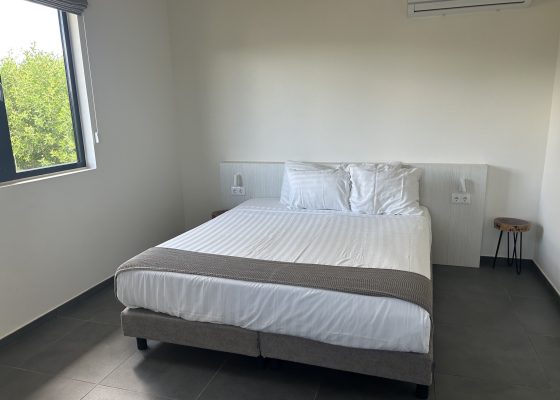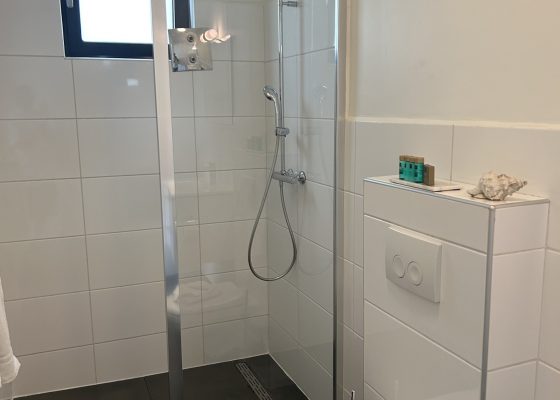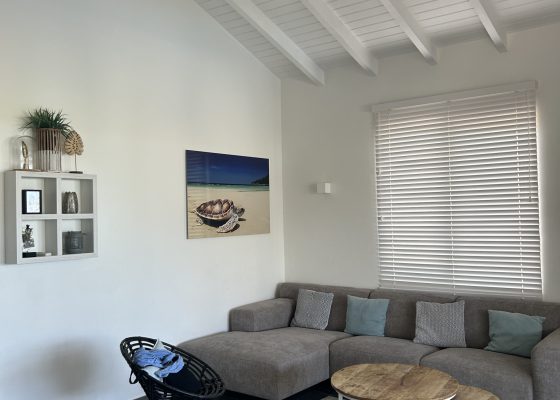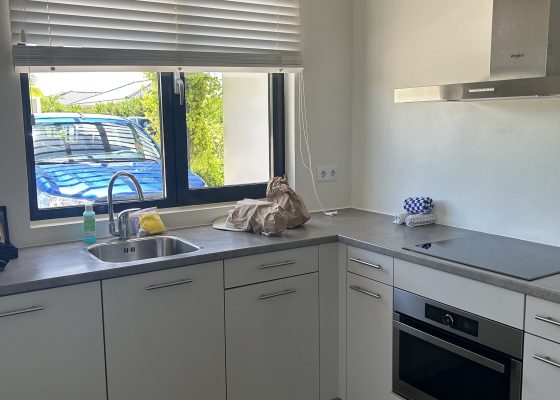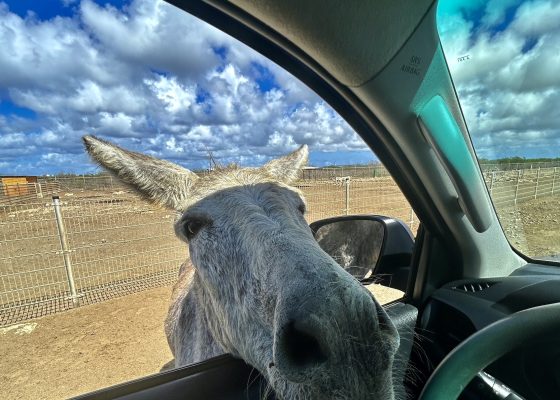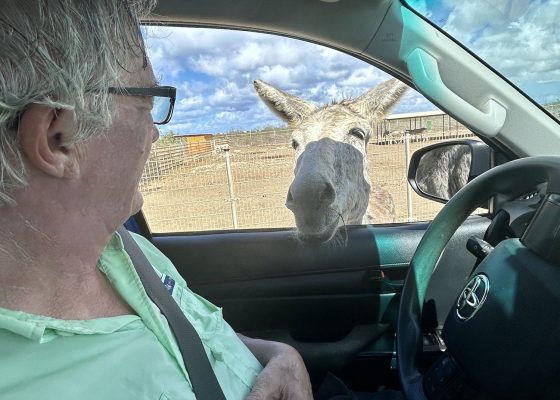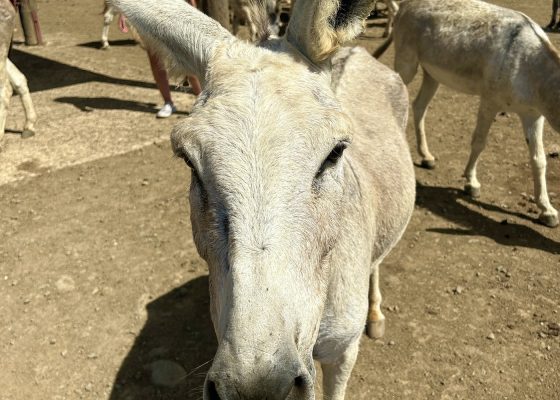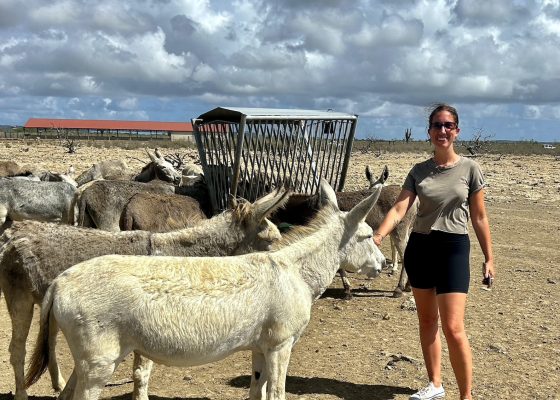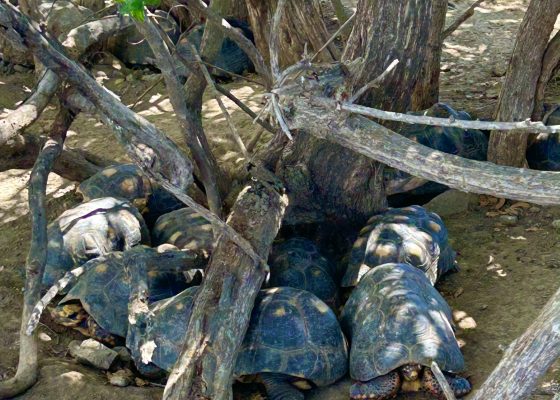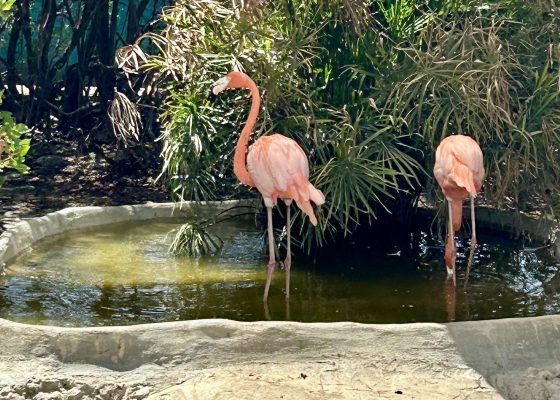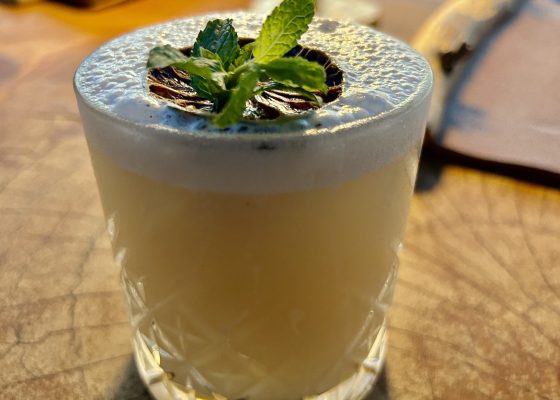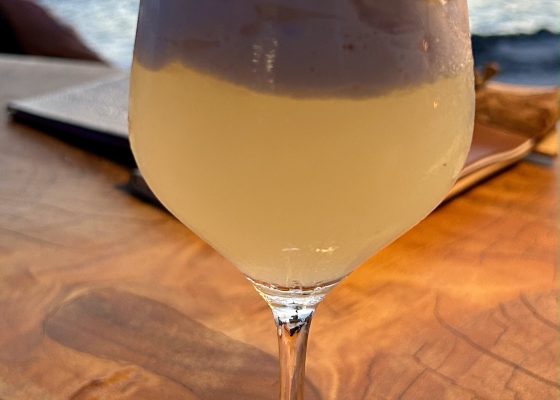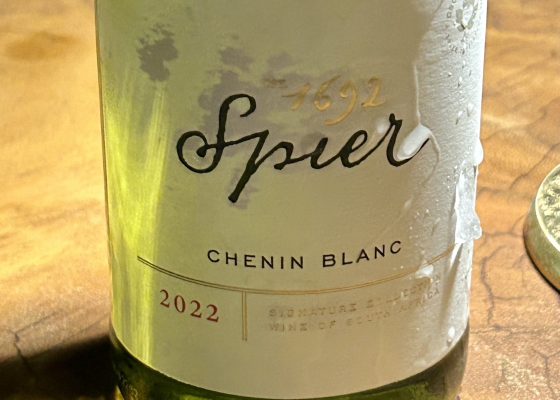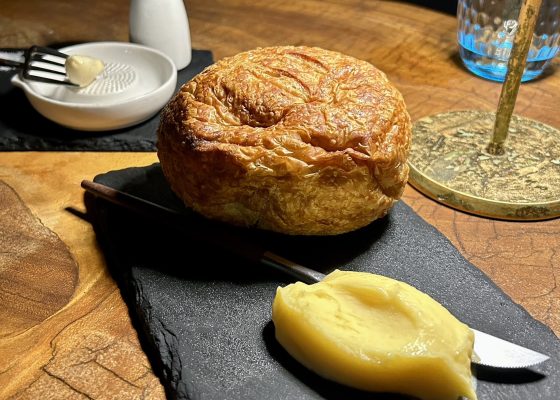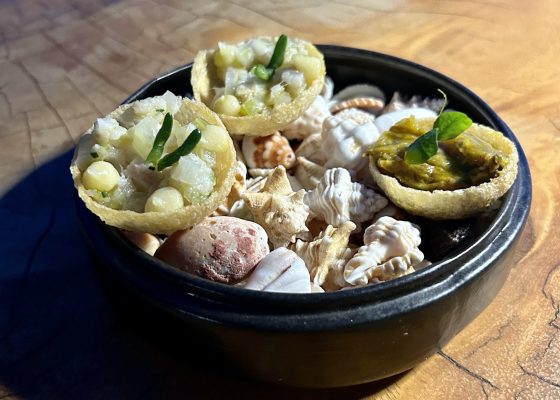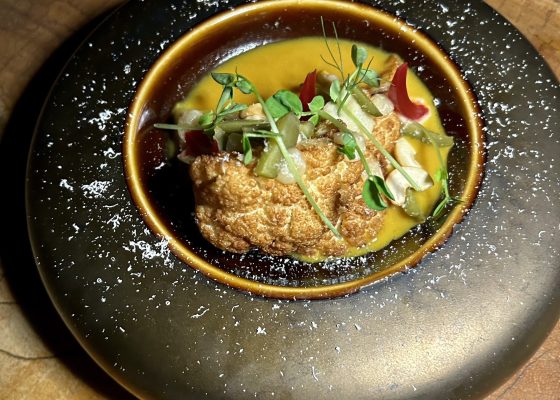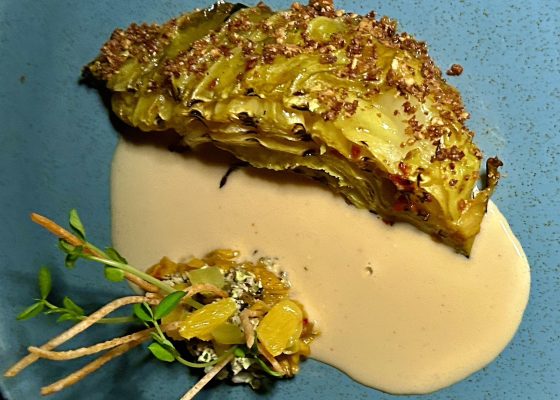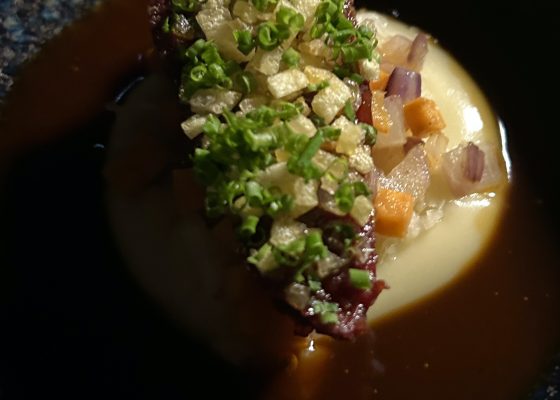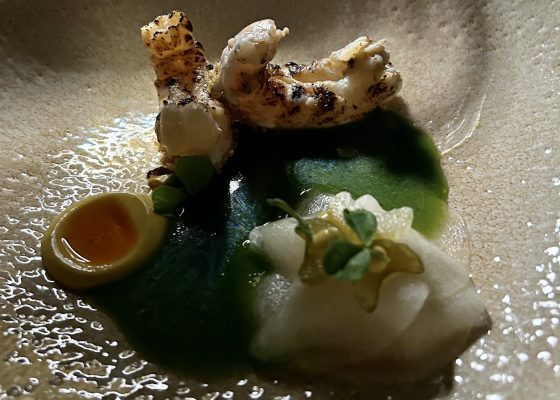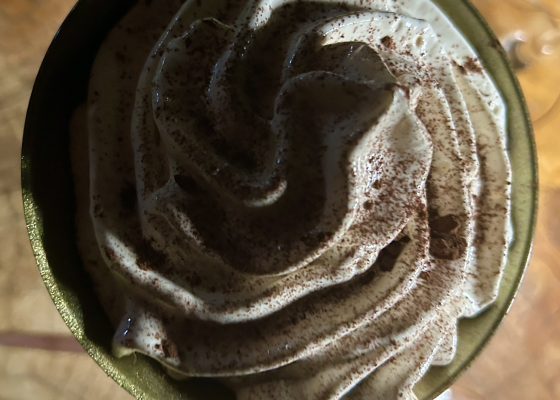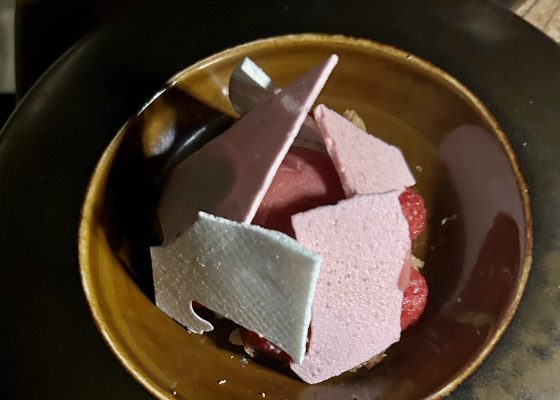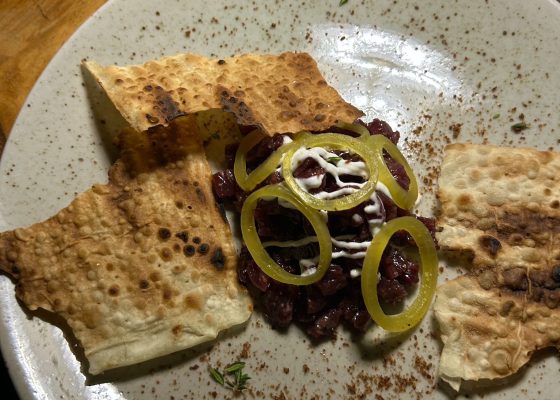Bonaire – A Quick Visit
In the fall of 2023 we returned to Landhuis Jan Thiel in Curacao for the first time since Covid. It is one of our favourite places on earth and we found things much the same as before the pandemic, enjoying morning walks around the salt lake with Digger and Dingo, the resident dogs. We stayed for ten days rather than the usual week and decided to spend three more visiting nearby Bonaire which has long been on our list of Caribbean islands to check out. While our visit was short, it was long enough to see much of what the island has to offer. Here are my reasons why you too should add Bonaire to your bucket list, if only for a one time visit.
History of Bonaire
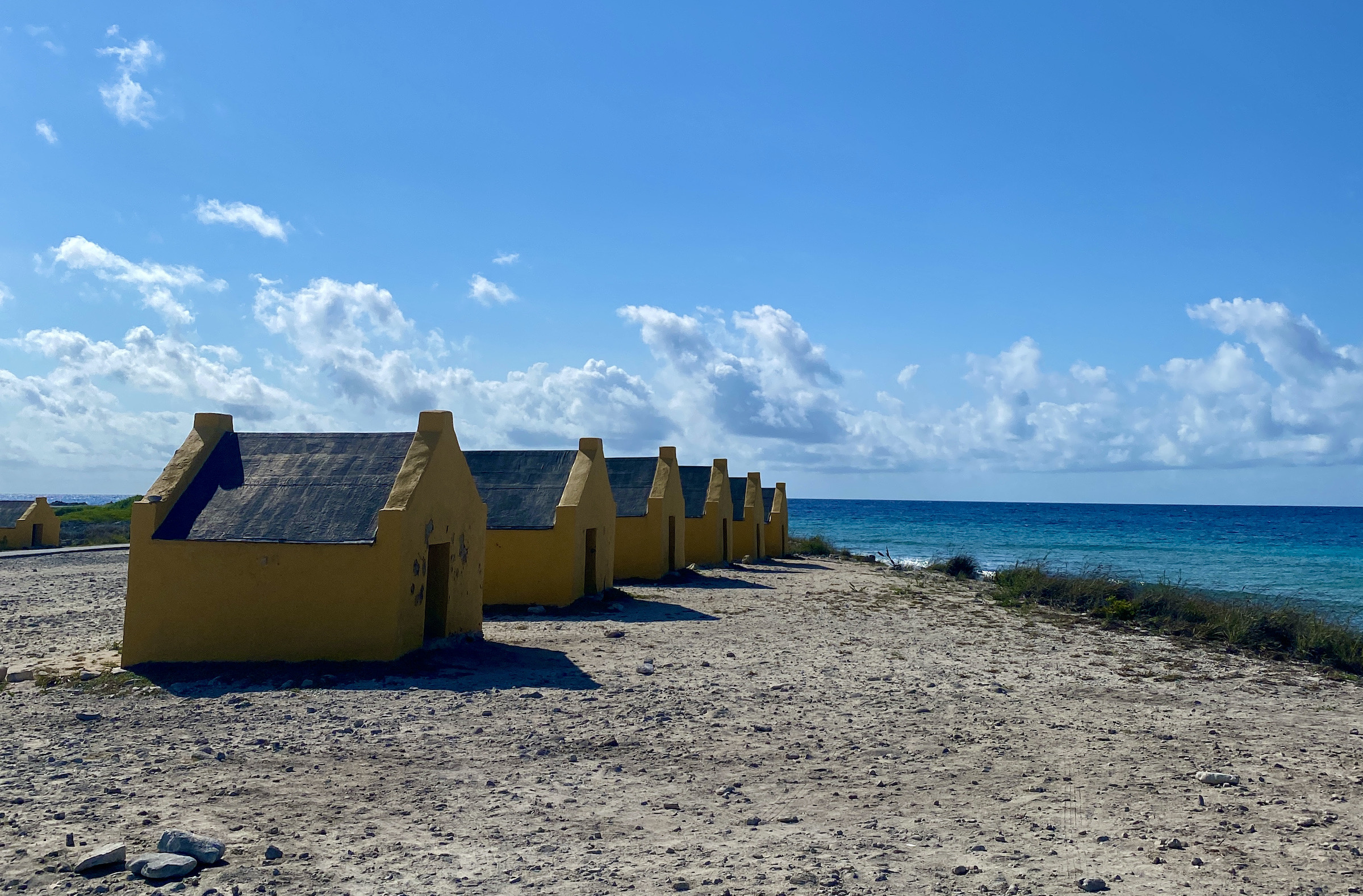
Given Bonaire’s proximity to the coast of Venezuela it is not surprising that the original inhabitants were the Caiquetio, a part of the larger Arawak group of Indigenous people that first inhabited much of northern South America. They were living what some would call a Stone Age existence when the first Europeans arrived in 1499. Alonso de Ojeda and his navigator Amerigo Vespucci (the guy from whom the name America derives) found little of use on the island except the native inhabitants who they and later Spanish visitors rounded up and took away as slaves, beginning the long history of that practice on Bonaire.
In 1526 the now uninhabited island began being used as a place to raise cattle, sheep, goats and donkeys which were simply allowed to roam free unattended by herders. That practice reverberates to this day as Bonaire still has large herds of feral donkeys and goats, making it quite different than the neighbouring islands of Curacao and Aruba. Eventually a few Spaniards did settle on Bonaire creating the village of Rincon in 1527 which is as far inland as you can get on the island, making it a safe oasis from pirates. It is the oldest European settlement in the Dutch Caribbean and one of the oldest in the New World.
Speaking of the Dutch they arrived in 1636 and ousted the Spanish from Curacao, Bonaire and Aruba and maintained control almost continuously since then. The Dutch West India Company made Curacao the centre of the African slave trade in the Caribbean as I documented in this post on the Kura Hulanda Museum in Willemstad. Bonaire was made into one giant plantation producing salt which was a valuable commodity in the 17th and 18th centuries. It was during this time that the incredibly small slave huts were built that you can still see today on the shores of the south part of the island such as shown in the photo above.
Here is another photo with me providing some scale as too just how tiny these dwellings were. I cannot imagine living in one of these given the heat and lack of fresh water, but slave families spent their entire lives in places like these. And no the sign on the rock does not refer to me as a white slave, but to the colour of the building.
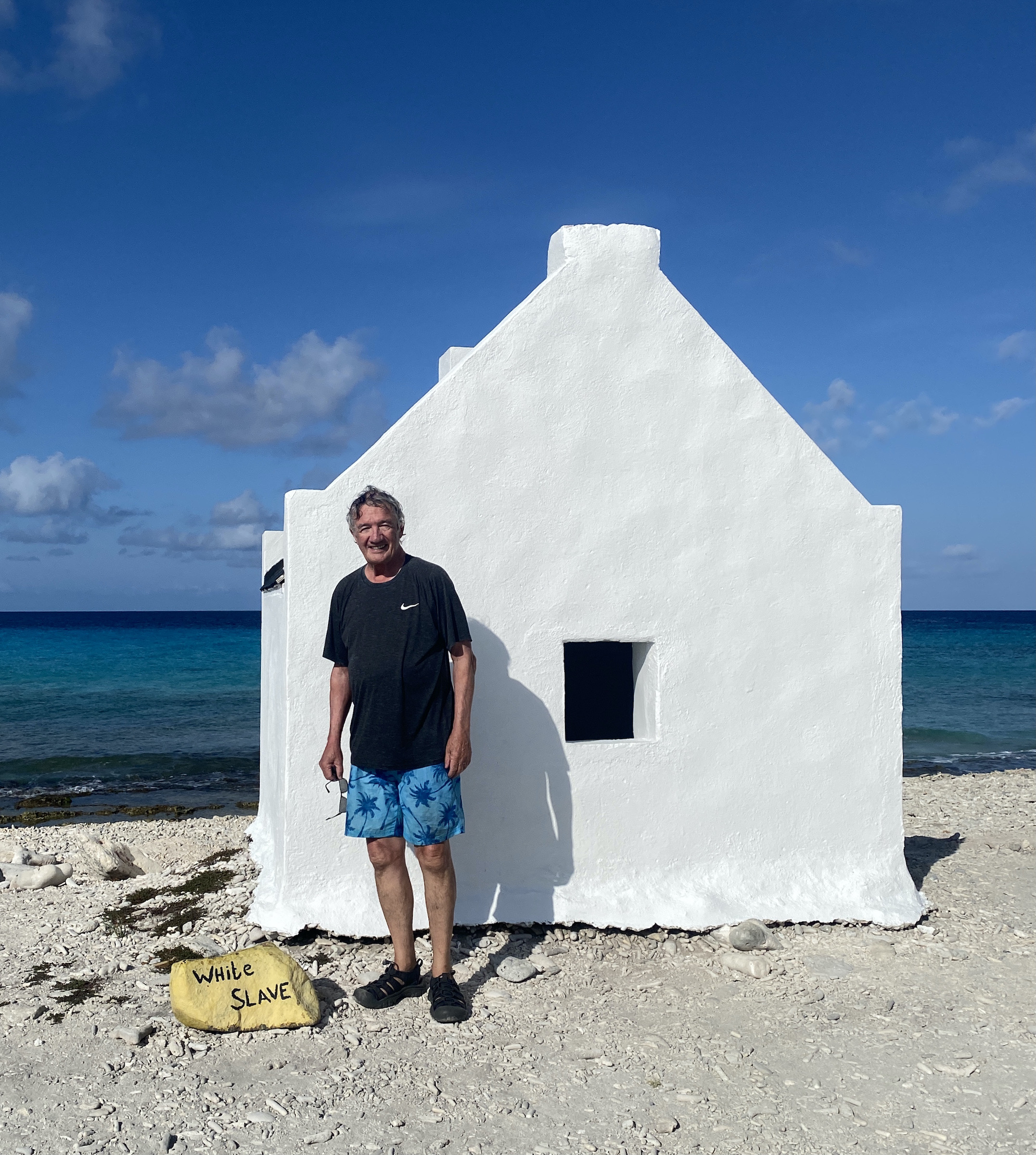
During the Napoleonic Wars the Dutch lost control of Bonaire for a period long enough that white settlers founded the island’s largest settlement, Kralendijk in 1810. When the Dutch regained possession they made Bonaire a government owned plantation with over 300 government owned slaves. I am not aware of any other instance in the New World where the government as opposed to private individuals actually claimed ownership of human beings. Slavery was abolished in 1862 by which time there were over 600 government owned slaves working the salt pans of Bonaire. It took over 160 years, but the Dutch government finally apologized for its heinous role as a slave owner in 2022. I am not really a believer in the idea of reparations by the government to the descendants of people who were maltreated in the distant past, but in the case of the descendants of these government owned slaves, I would make an exception.
Not too much of note has happened on Bonaire in the past couple hundred years. In WWII it had an internment camp for German and Austrian nationals living in the Dutch West Indies, many of whom had actually fled to the islands to escape from the Nazis. After the war the camp became the first hotel on Bonaire and tourism has been the backbone of the economy ever since, although Cargill still operates a gigantic sea salt operation that takes up a good portion of southern Bonaire.
In 2005 a referendum saw the residents opt to become a special municipality of the Netherlands and it is technically a part of that country, but inexplicably they do not have access to the same social programs as do those living in Europe. Given the tiny size of the population, just over 20,000, it would hardly hurt the Dutch economy to extend these benefits to the Bonairians. Still, while there is some poverty in Bonaire, its standard of living is quite high and vastly above many other Caribbean nations.
One final note – the name Bonaire does not come from the French for ‘good air’, but rather from the original Caiquetio word for the island.
Visiting Bonaire
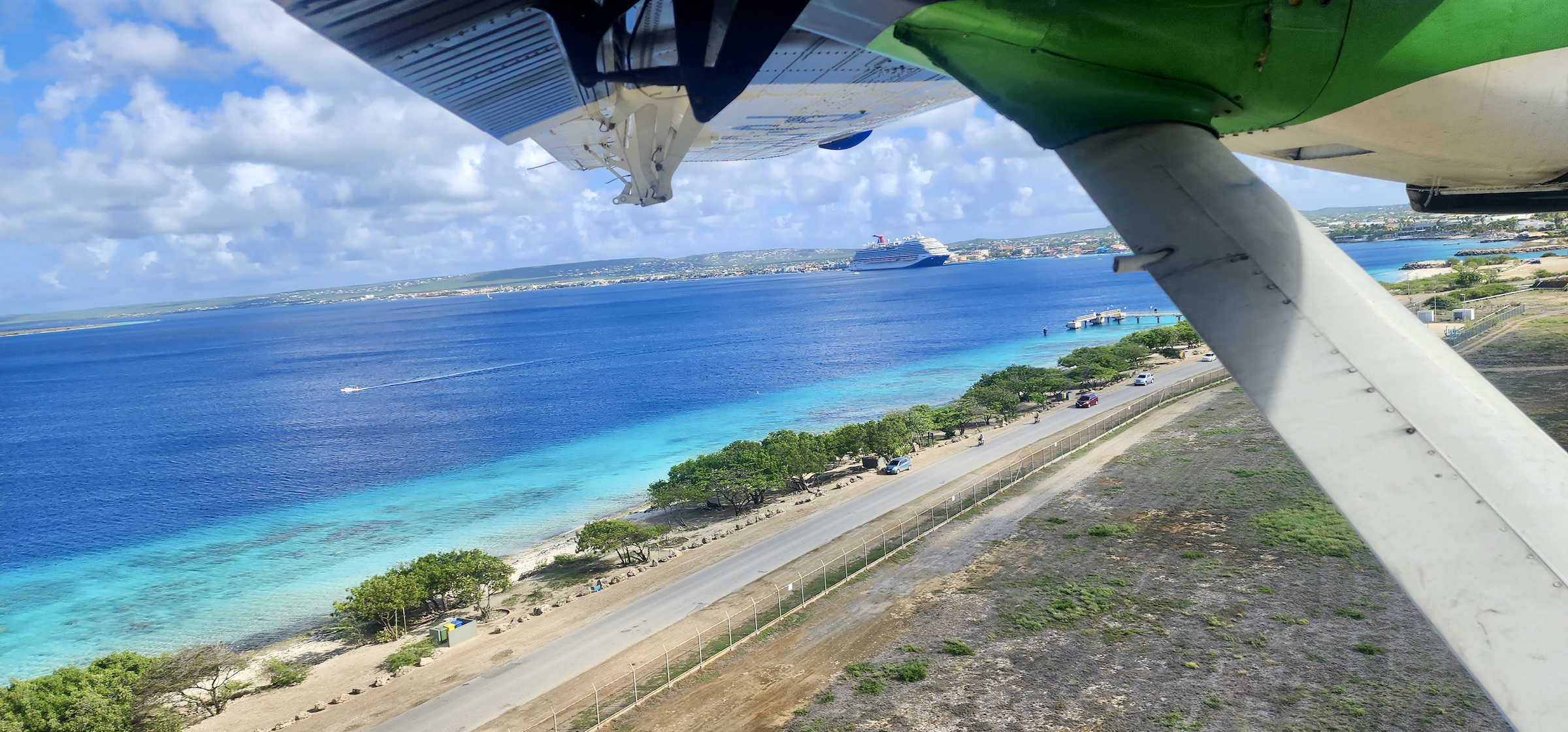
Bonaire is considered to be one of the best places in the world for both diving and snorkelling and according to Bonaire Pros has been voted the best place in the world for on shore diving for 23 straight years. This means that you don’t need to get into a dive boat to have a great experience. For snorkelers like Alison and me, it means the same thing and that is the primary reason we decided to come to Bonaire.
Since 2022 Bonaire has required all visitors to pay a Visitor Entry Tax of $75 USD which you can pay here. You will also need to pay a further $40 USD fee if you want to enter Washington-Slagbaai National Park or any of the marine areas with a private company. Technically you are supposed to pay this even if you go snorkelling or diving on your own, but there doesn’t seem to be any enforcement mechanism to collect the fee. You also need a valid passport and return ticket which you may be required to show as you pass through Dutch customs and get the stamp indicating you are in an EU country.
While there are direct flights to Bonaire from a number of US cities and from Amsterdam, we arrived via Divi Divi Air, a local company that services the three ABC islands. The flight is less than 30 minutes and costs around $180 USD return. Flamingo airport was built by the US during WWII and is surprisingly large for such a small place.
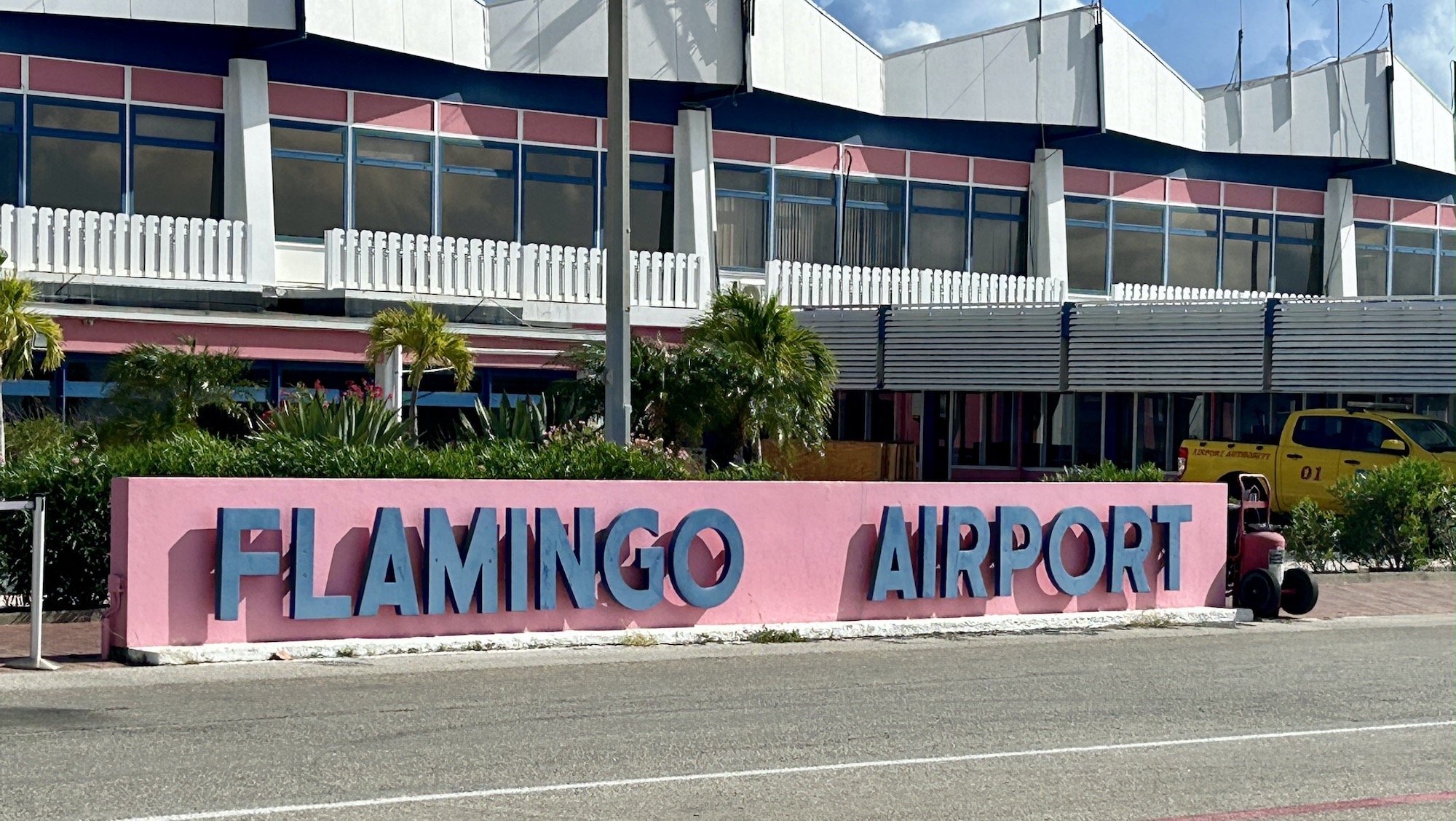
You will need a vehicle to get around Bonaire and most of the major rental companies have offices just outside the terminal. If you plan to visit Washington-Slagbaai National Park you absolutely need to rent one of the Toyota Hilux pickups that are ubiquitous on Bonaire. They are dubbed ‘Mr. Indestructible’ for good reason as we found out.
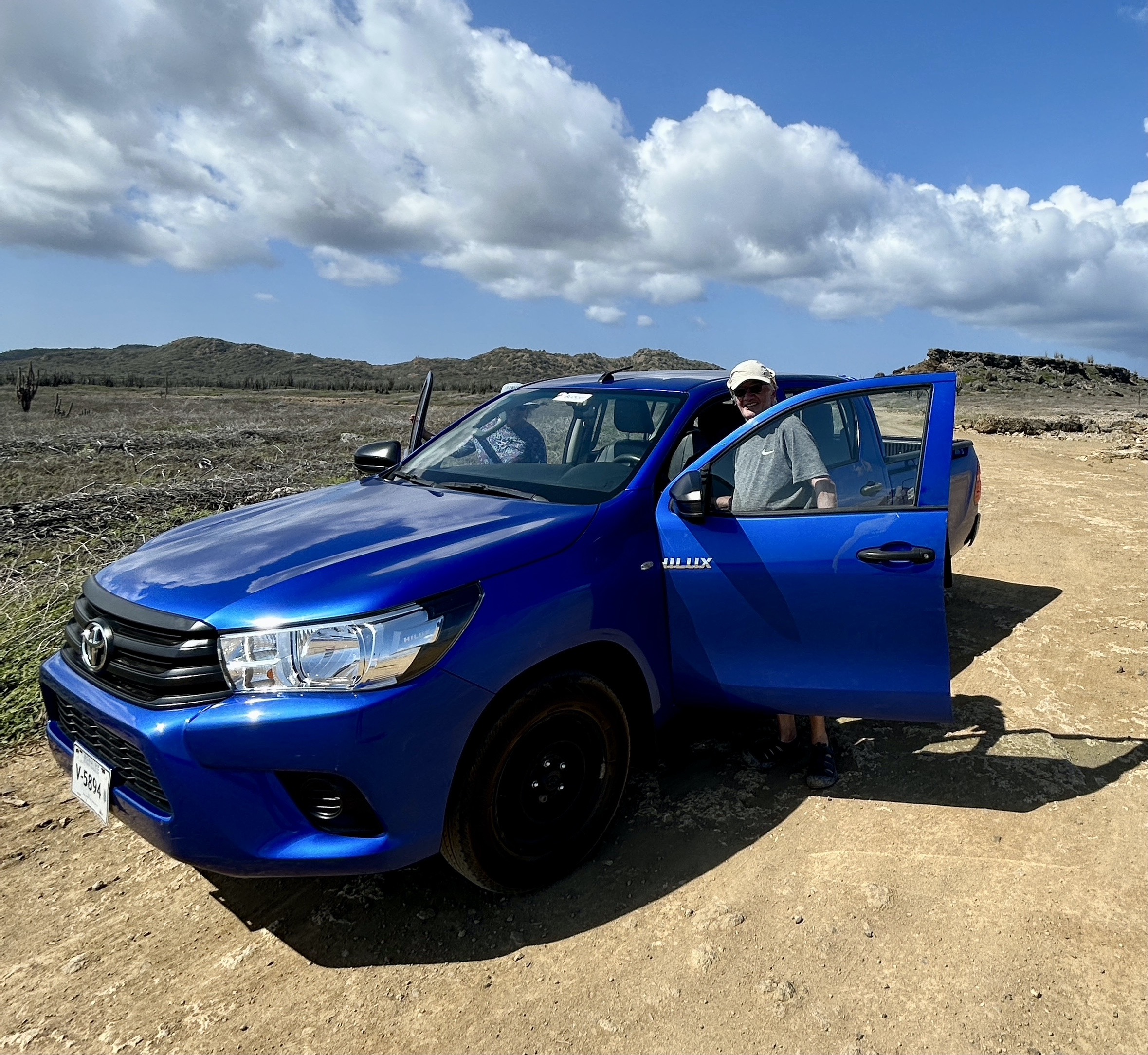
In terms of where to stay on Bonaire we chose the Grand Windsock Resort which is right next to the airport and within easy driving distance of Kralendijk as well as some of the best snorkelling sites. Te Amo beach, one of the best on Bonaire, is within walking distance. For around $200 USD a night we got a very modern three bedroom unit with a large and private outdoor patio and small pool. While not on the beach it is just across the road from it.
- Bedroom 1
- Bathroom 1
- Living Area
- Kitchen
- Outdoor Patio and Pool
In terms of supplies Bonaire has some great supermarkets and wine stores, easily as good as any on Curacao. They are all on the outskirts of Kralendijk within a few minutes of the Windsock resort.
OK, so we are on Bonaire with a place to stay and a vehicle to get around in, let’s find out what there is to see and do on this Dutch outpost.
The Donkey Sanctuary
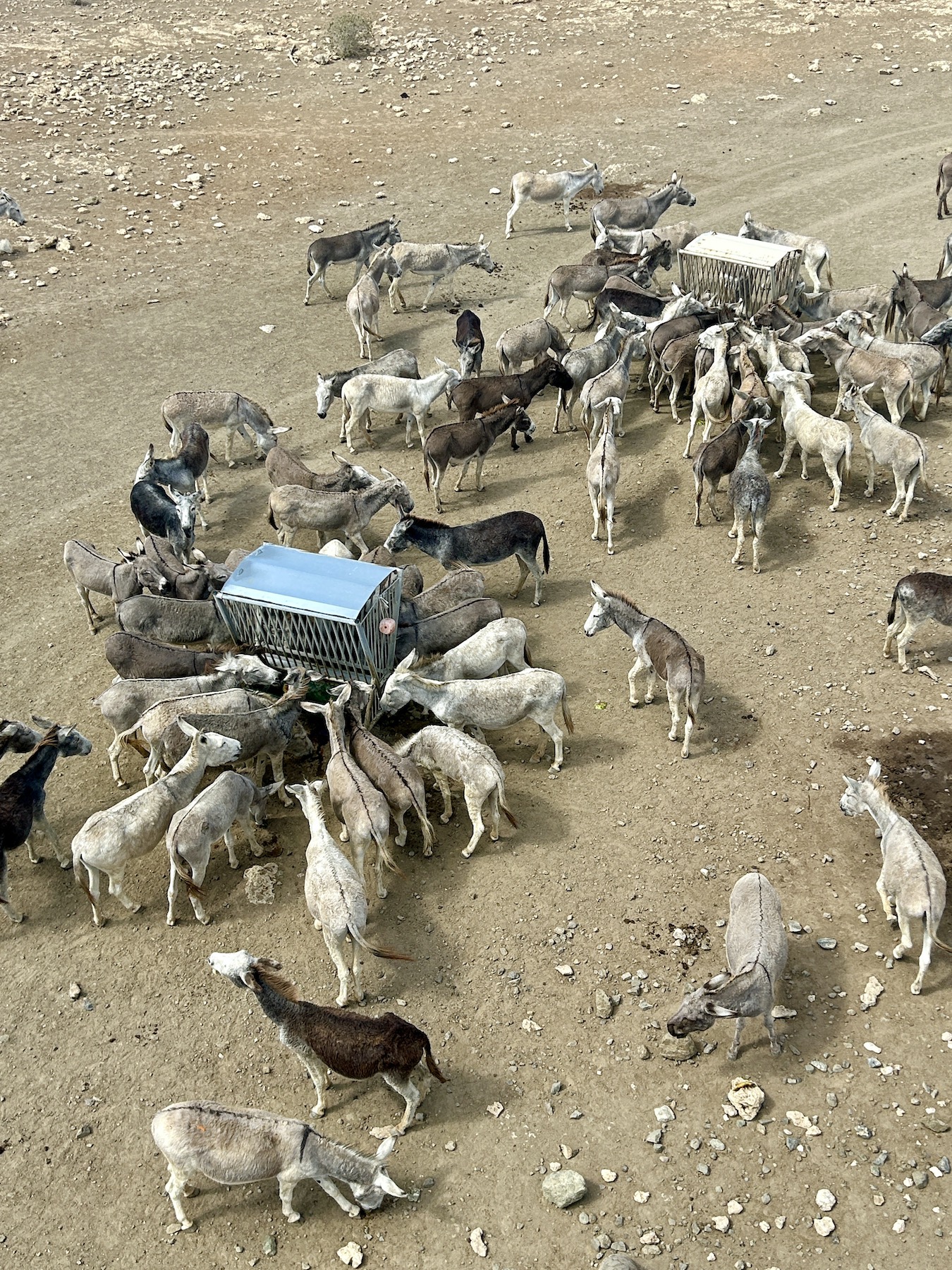
As noted in the history of Bonaire, donkeys were brought to the island by the Spanish over 400 years ago and they have flourished in the arid environment, so much so that they are generally considered to be a nuisance. The Donkey Sanctuary Bonaire was established by a Dutch couple in 1993 and now houses over 800 donkeys. It has become one of the island’s main tourist attractions, particularly for people like our daughter Lenore who likes sanctuaries for animals, but not zoos. Volunteers come from all over the planet to assist in the ongoing rescue efforts.
I was a bit skeptical at first, but quickly succumbed to the charm and curiosity of these creatures that will live out their lives here, without the worry of being hit by a car as many of the remaining wild donkeys are. You can get out of your car and walk among them or just drive around the sanctuary where you will encounter most of the 800 residents. There are also some tortoises and flamingos undergoing rehab here as well. I highly recommend a visit during your stay in Bonaire; it’s one of those places that makes you feel good that you went.
- Can I come in?
- Dale and the Donkey
- You Looking at Me?
- Lenore & the Donkeys
- Tortoises
- Injured Flamingos
Well, what about the snorkelling?
Here’s the problem for first time visitors like me. Bonaire has over 85 sites around the island that are designated by brightly painted yellow rocks as onshore snorkelling or diving sites. Obviously you can’t try them all or even a fraction of them on short visit, so how do you decide which ones to visit first? The answer would normally be to check out the various sites on the internet that specialize in snorkelling – there are dozens of them. But here’s the rub. They are wildly different in their lists of the best places to snorkel in Bonaire. What appears as the #1 site on one website doesn’t even appear in the top 10 on another website. In others words there’s just no consensus on the best places to snorkel in Bonaire.
Once I realized that, it was a matter of picking out one place that seemed to appear somewhere in every website’s list of the best places and that turned out to be a place called Wayaka II in Washington-Slagbaai National Park. This, the first national park in the Dutch West Indies, is huge at 5,643 hectares (13,837 acres) and preserves the entire northern third of Bonaire. I was planning on visiting it anyway because it apparently has a lot more to see and do than just snorkelling at some of its beaches. So let’s spend our first full day in Bonaire exploring the park.
Washington-Slagbaai National Park
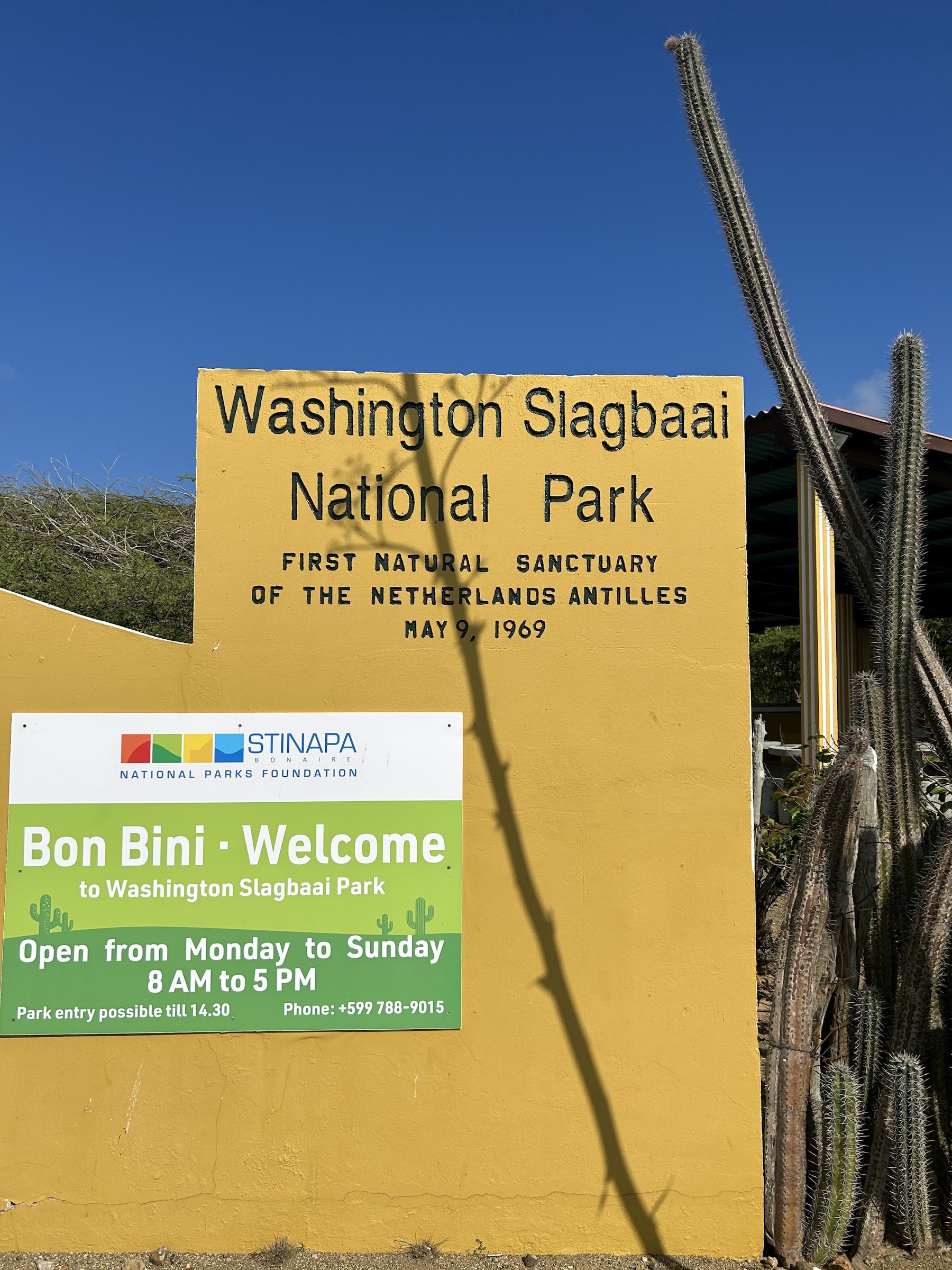
Comprised of two large plantations that raised goats for meat and milk and panned salt for hundreds of years, the park is now completely depopulated and reverting to its natural state. Its beaches are nesting sites for three sea turtle species and the offshore reef which in some places almost meets the shoreline, is home to hundreds of species of fish.
On the way to the park we pass a number of features that I have not seen anywhere else – fences made of cacti like this one. Apparently this is the only way to keep the feral donkeys and goats from getting onto your property and eating everything in sight.
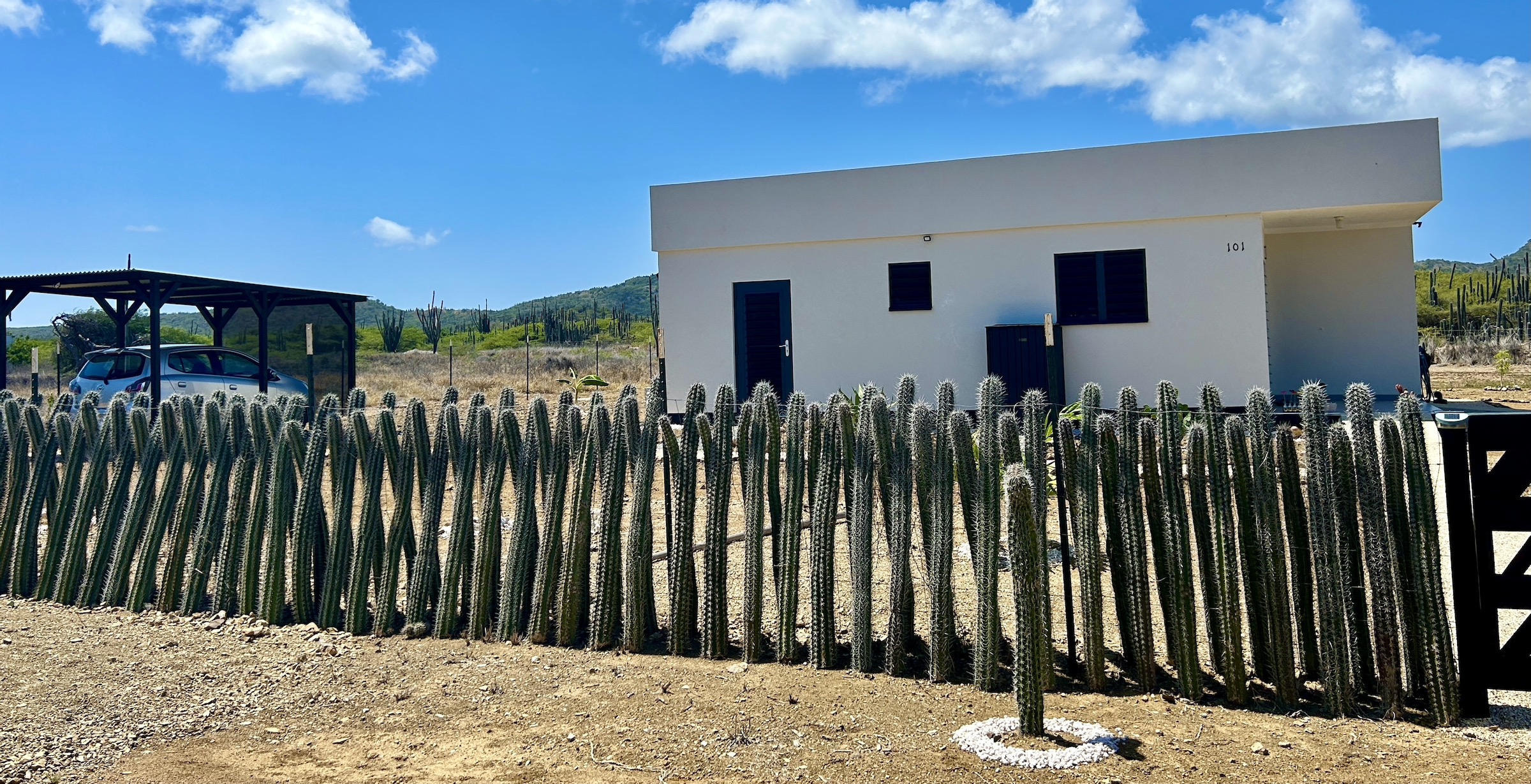
We arrive at the entrance to the park after passing through the town of Rincon. Here I get the unpleasant news that it will cost $40USD for each of us to enter. After paying the fee we are given a map and an explanation of the long way around which is 34 kms. (21 miles) and the short way at 24 kms. (15 miles). You can see the long route in yellow and the short one in green. They meet about halfway around. I am somewhat incredulous when the park attendant tells me it will take at least three hours to drive the long route. Really? That’s just over 10kms. per hour.
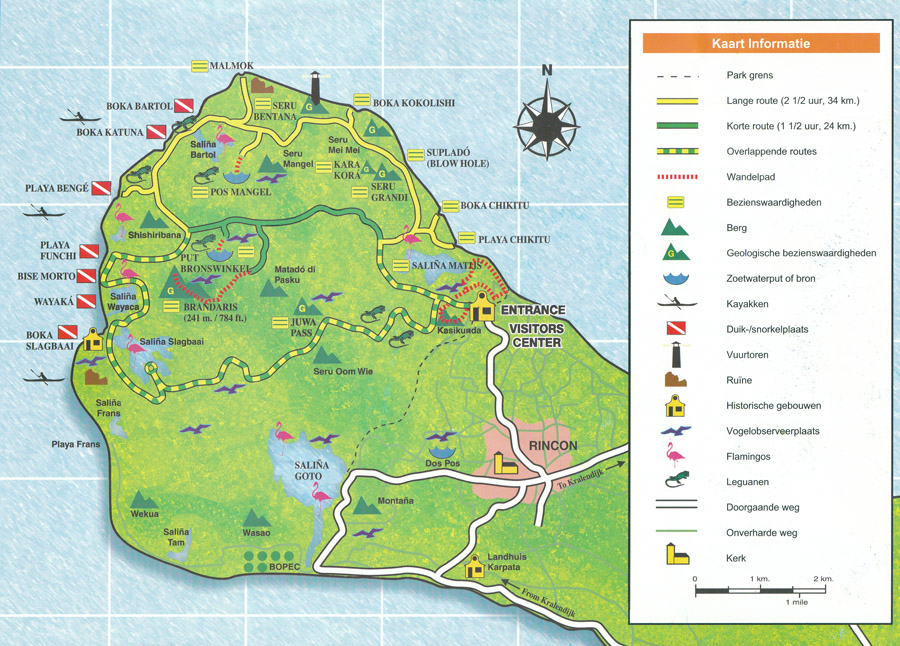
Before heading out we are required to have our snorkelling gear and footwear washed in sterilizing solution for five minutes.
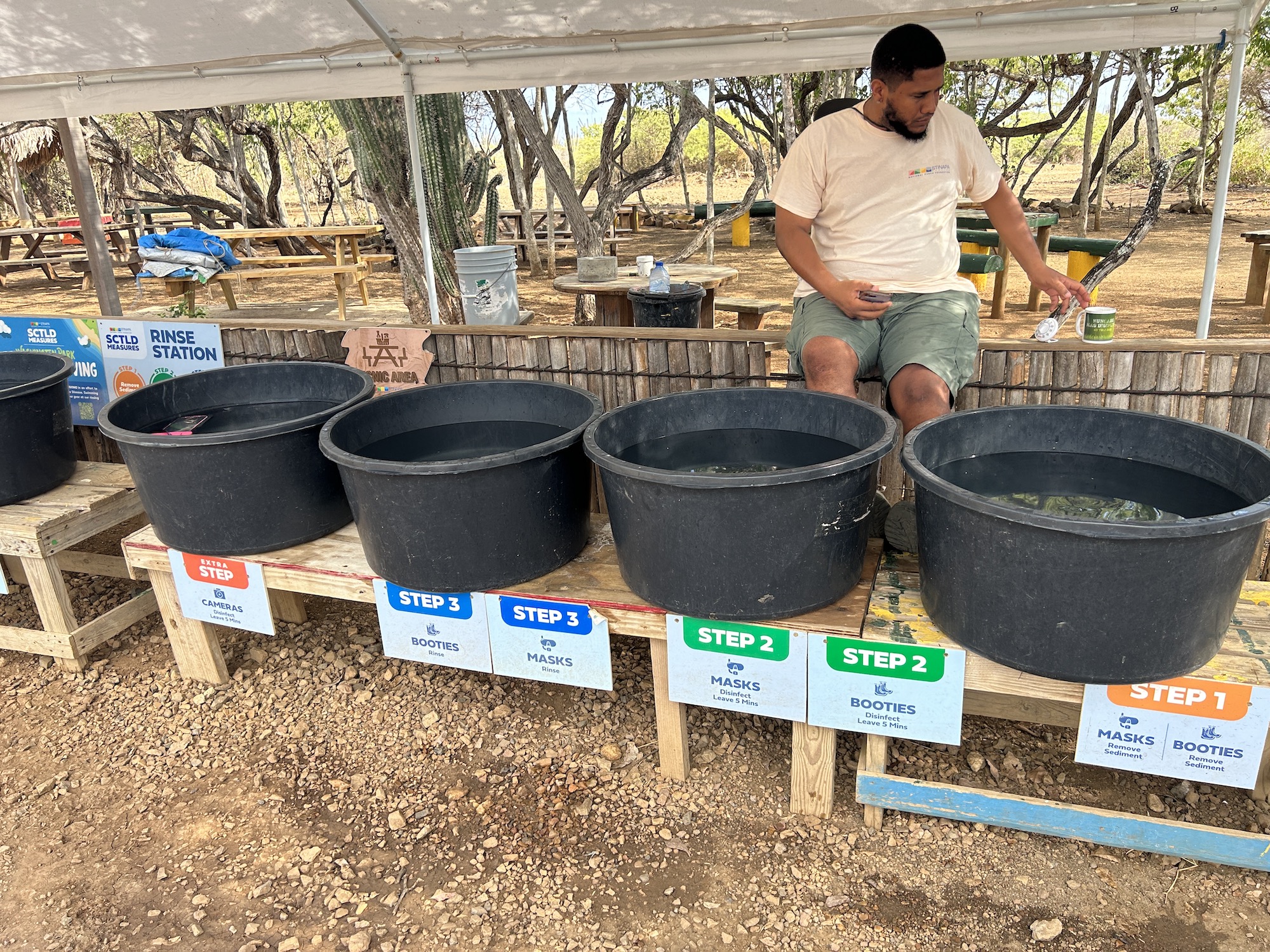
That gives us a chance to make a quick trip through the small museum at the entrance.
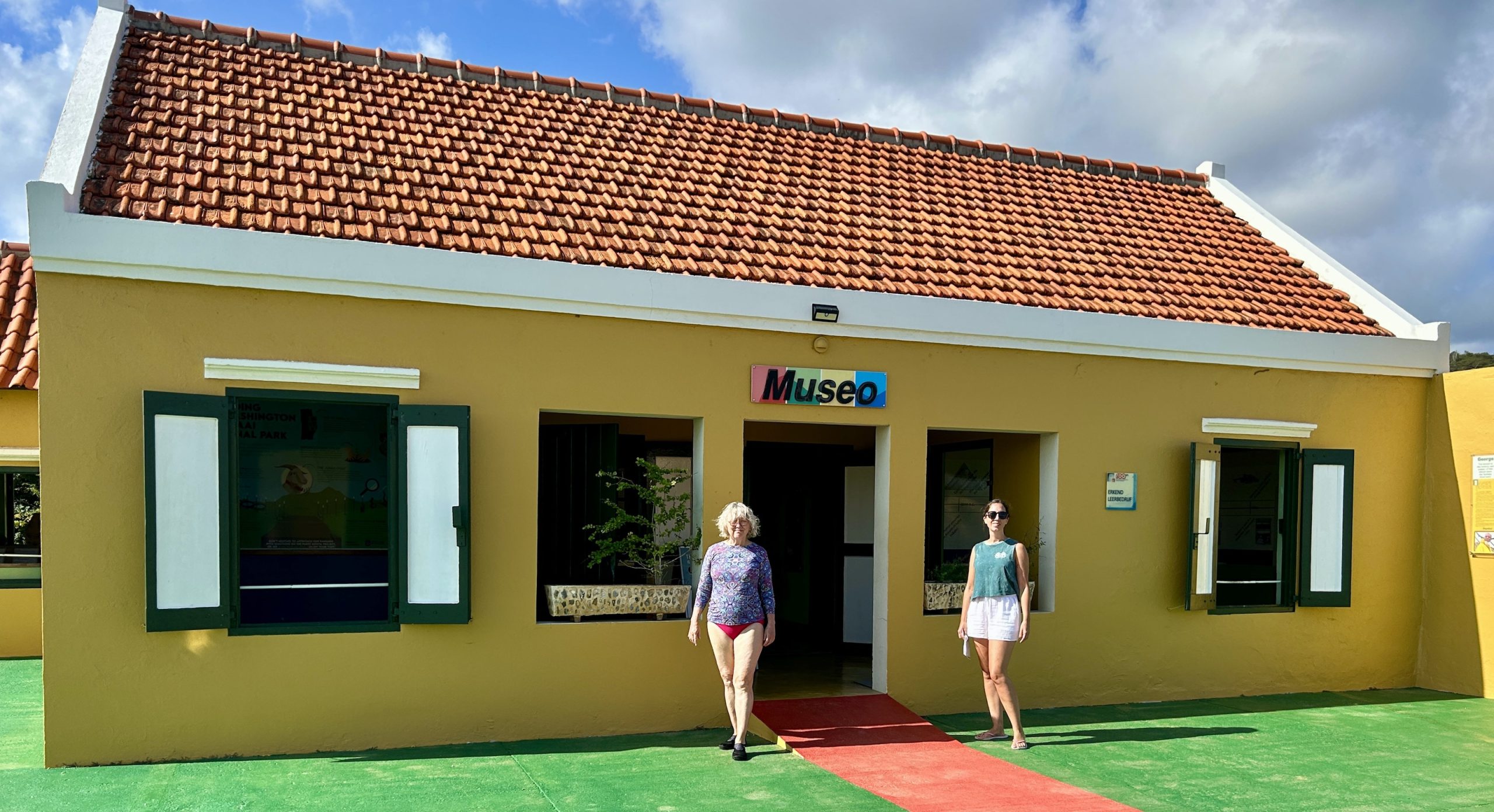
Back in the Hilux we agree that we will take the long route and after a couple of hundred metres it becomes apparent that the attendant wasn’t kidding about how long it would take to go around. The road is just about the worst I have ever driven upon and I genuinely feared having one of the tires blow on the sharp rocks. That didn’t happen, but it must be a frequent occurrence.
Our first stop was at what the map says is Playa Chikitu which would mean it was a beach, but somehow I missed the turn to it and ended up here at this inlet or boka, Spanish for mouth. There certainly was no beach and no place to attempt to snorkel. Even if I had found Playa Chikitu there is no swimming there because of rip tides.
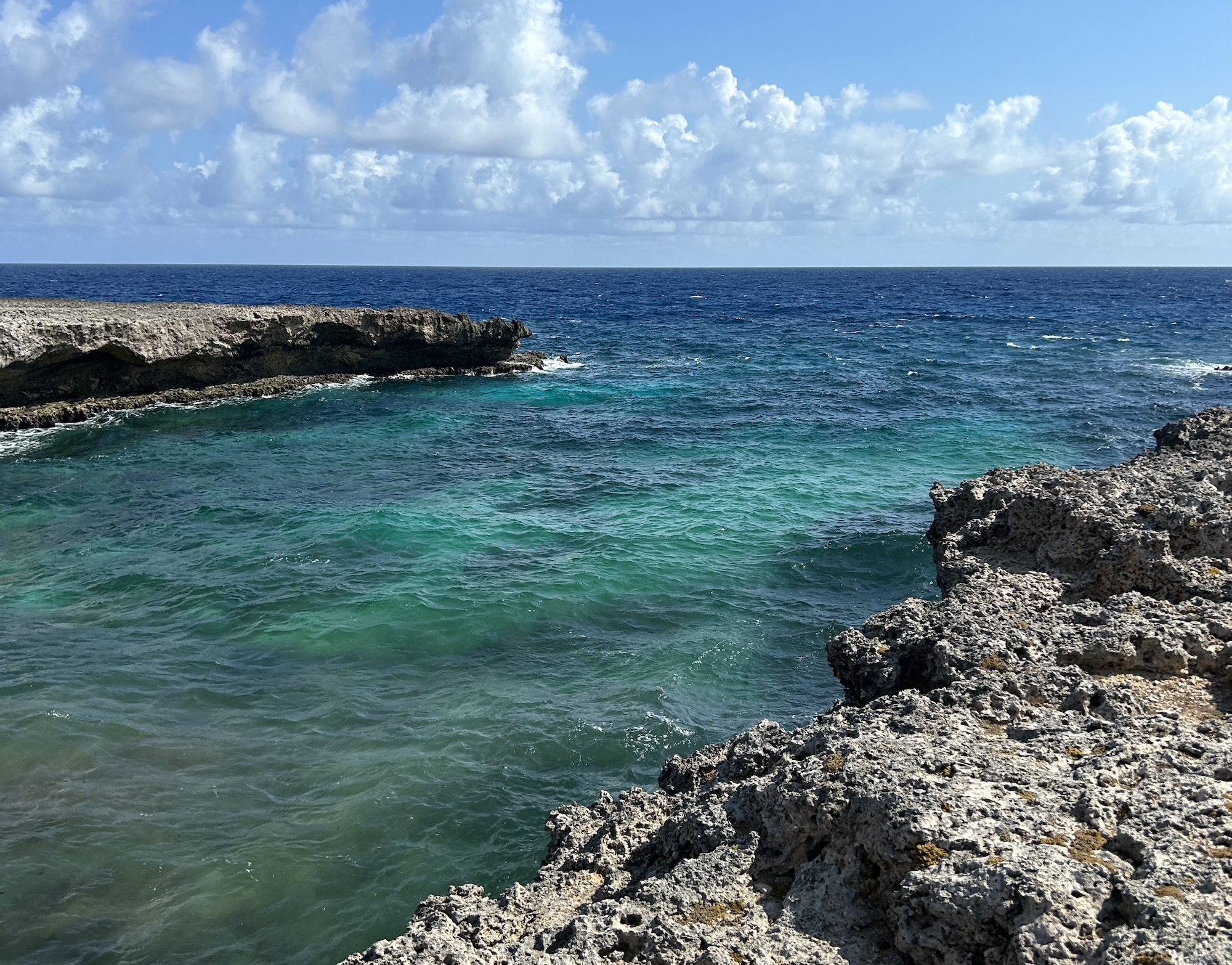
The landscape in this part of Bonaire is austere to say the least. There is little vegetation and no fresh water. This is the Seru Grandi Cliffs that are more impressive than this photo shows. They run for a number of kilometres on the opposite side of the road from the sea.
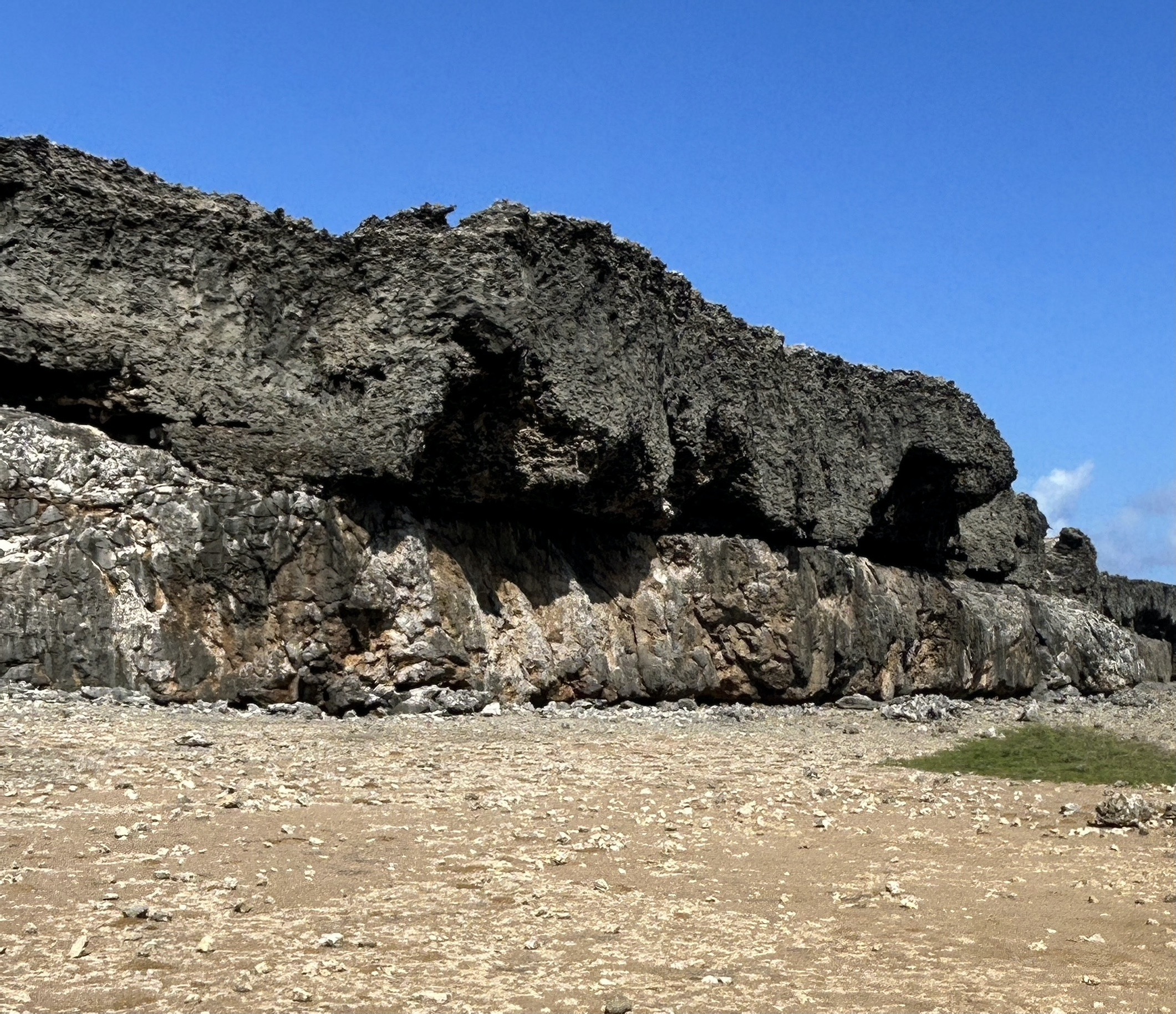
The suplado or blow hole turned out to be a dud, at least on the day we visited.
The first place of real interest was Boka Kokolishi where we were able to get down to the water in an inlet that was very picturesque with crystal clear water.
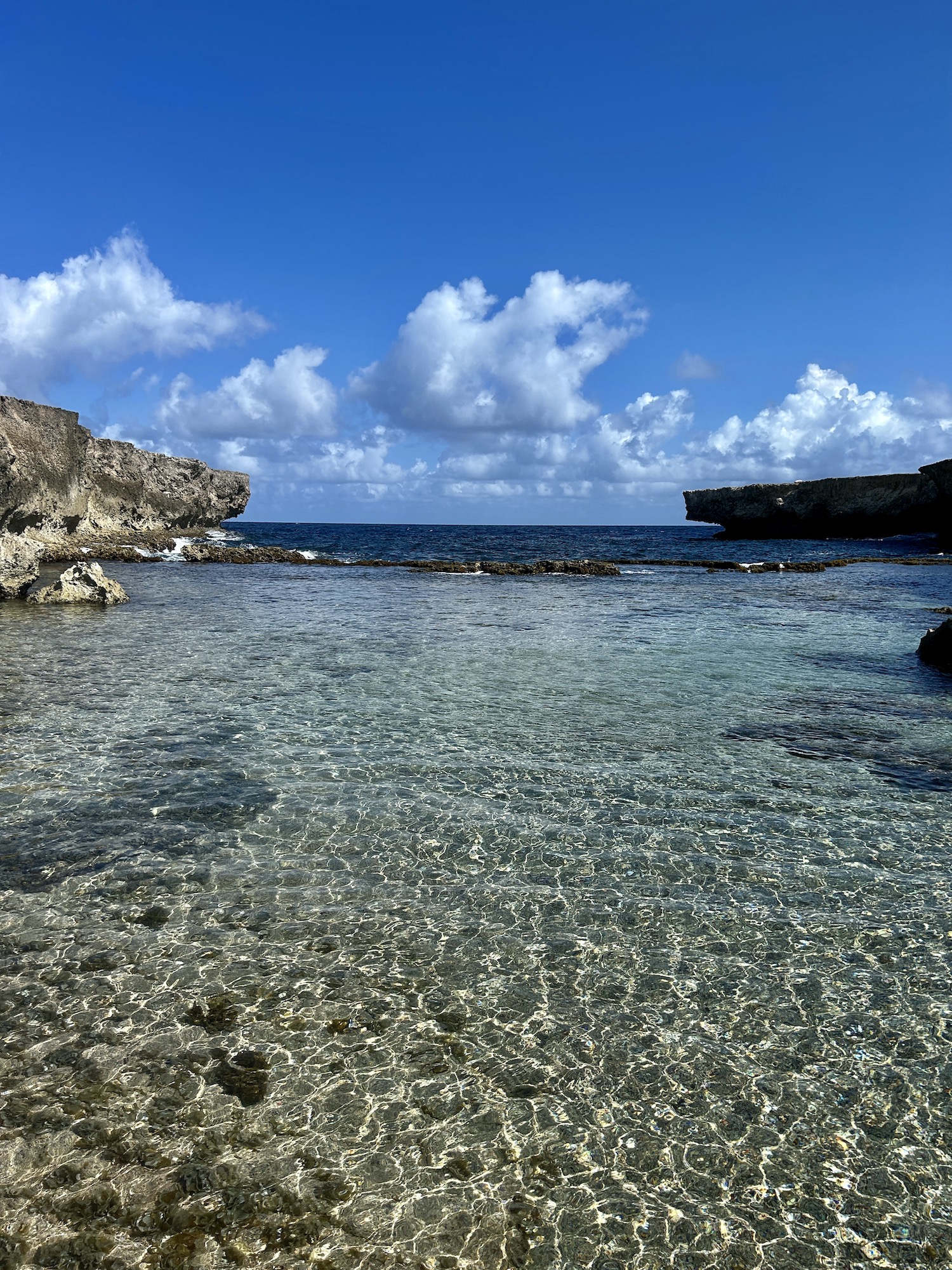
A nice place for photos, but not snorkelling.
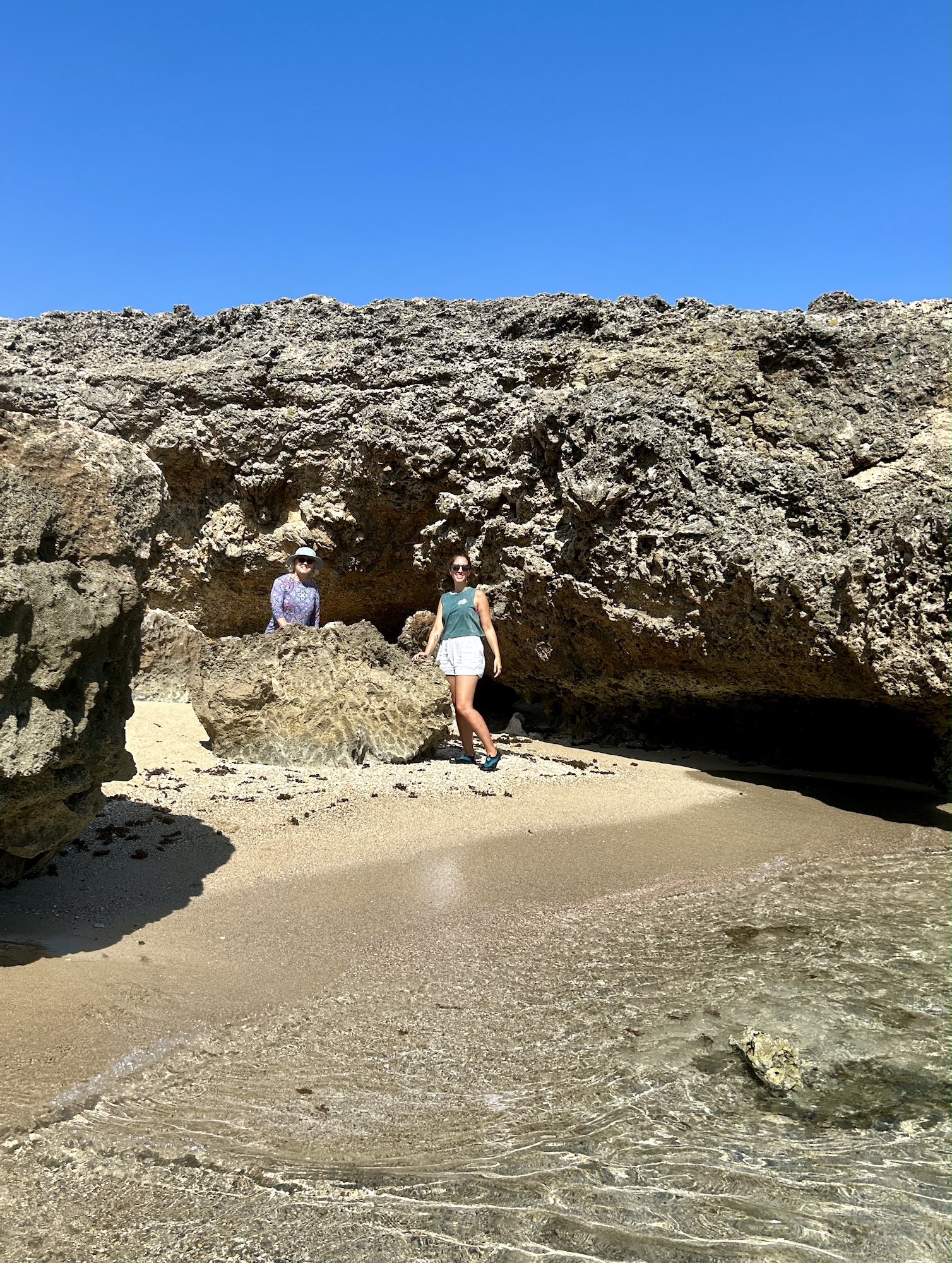
When you look down at Boka Kokolishi from above you can see why it’s not a place to snorkel.
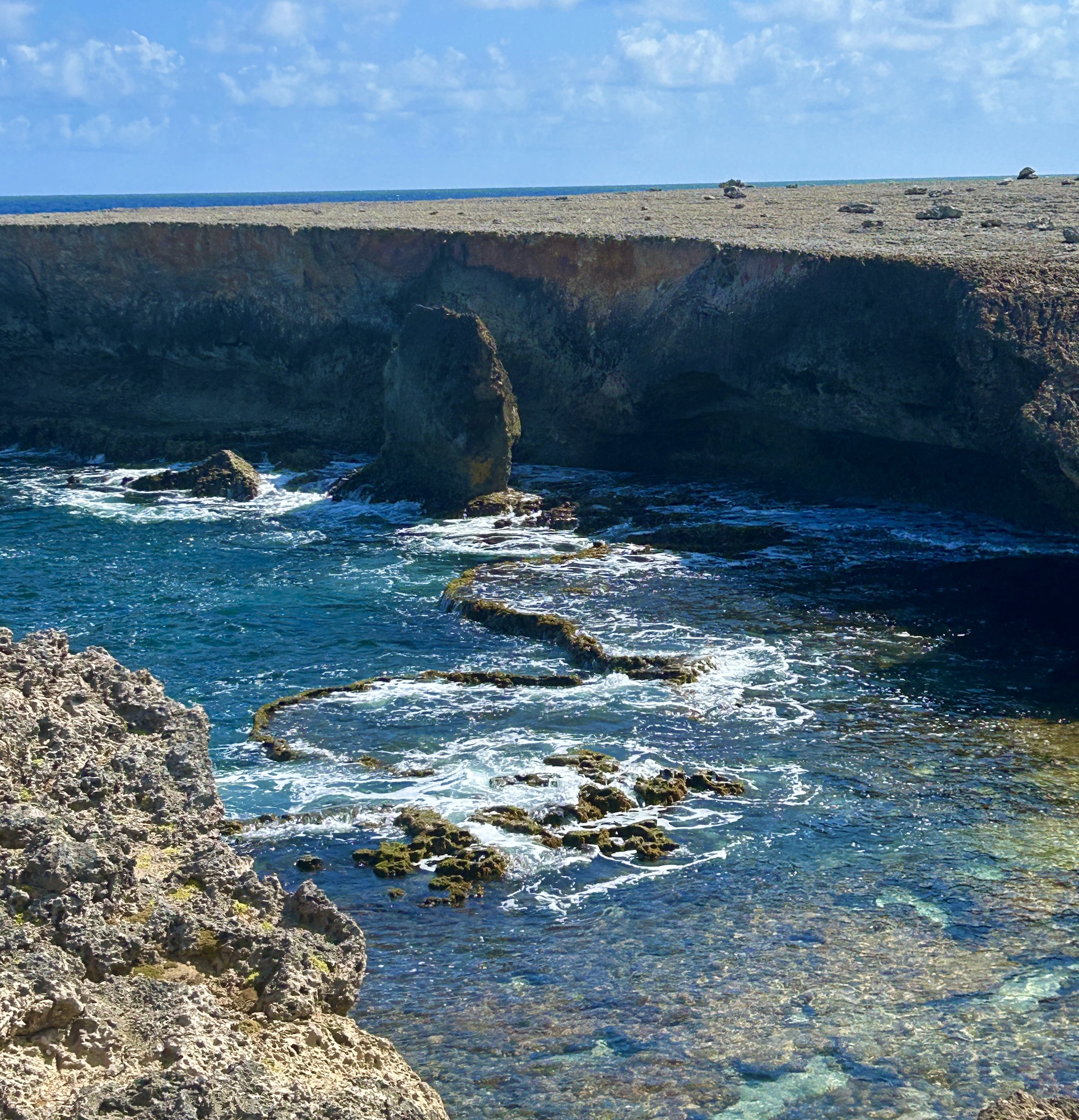
Next up were a couple of historical sites of modest interest. Seru Bentana lighthouse is almost blindingly white in the bright sunlight of this northernmost point on Bonaire. The Bonairians are proud of their lighthouses and all three of the working ones were restored to their original appearance in 2012. You can go inside, but not up to the top.
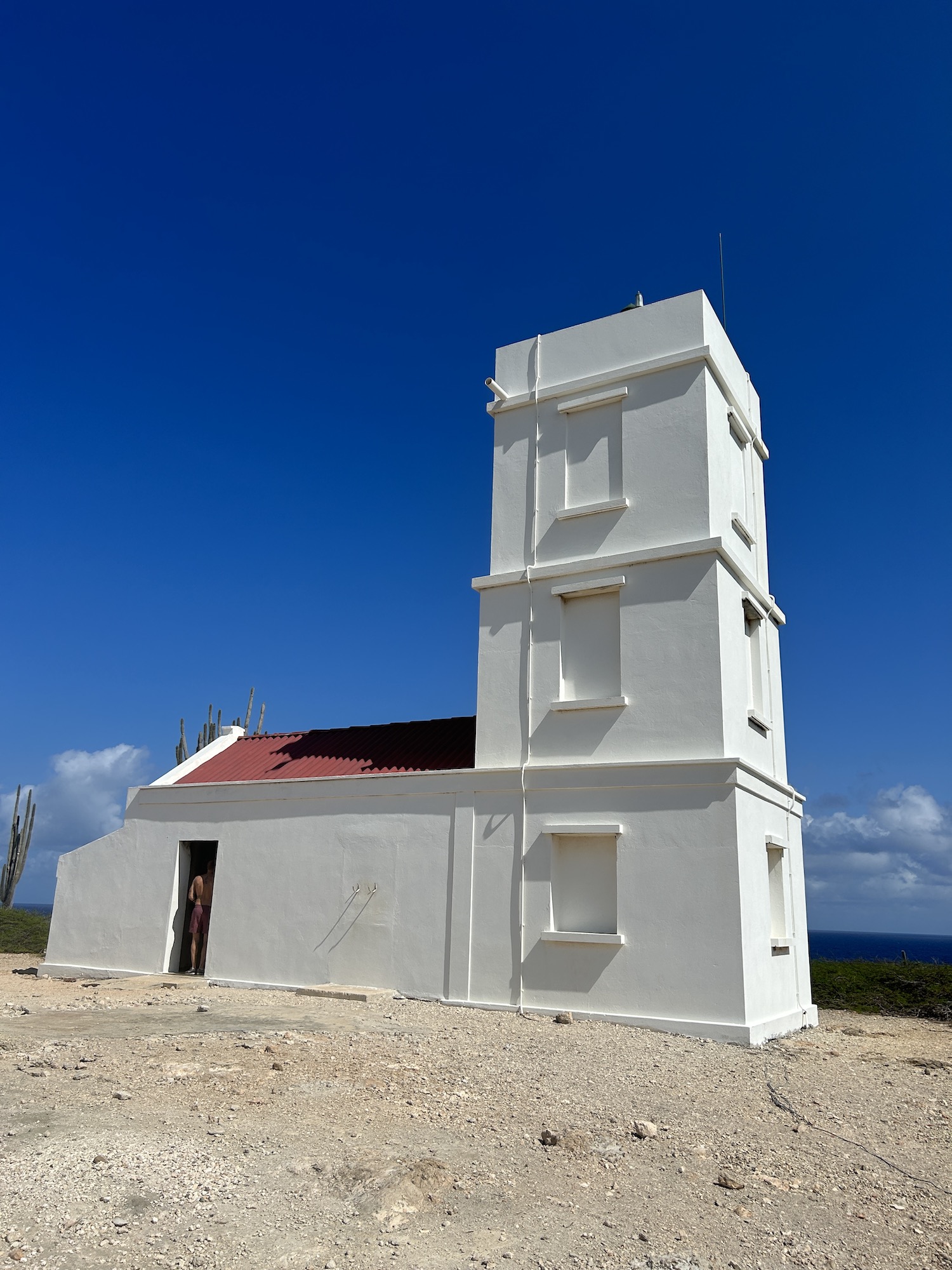
Further on are the unrestored remains of the tiny settlement of Malmok which once had a very small lighthouse and a research centre. Now this is all that remains.
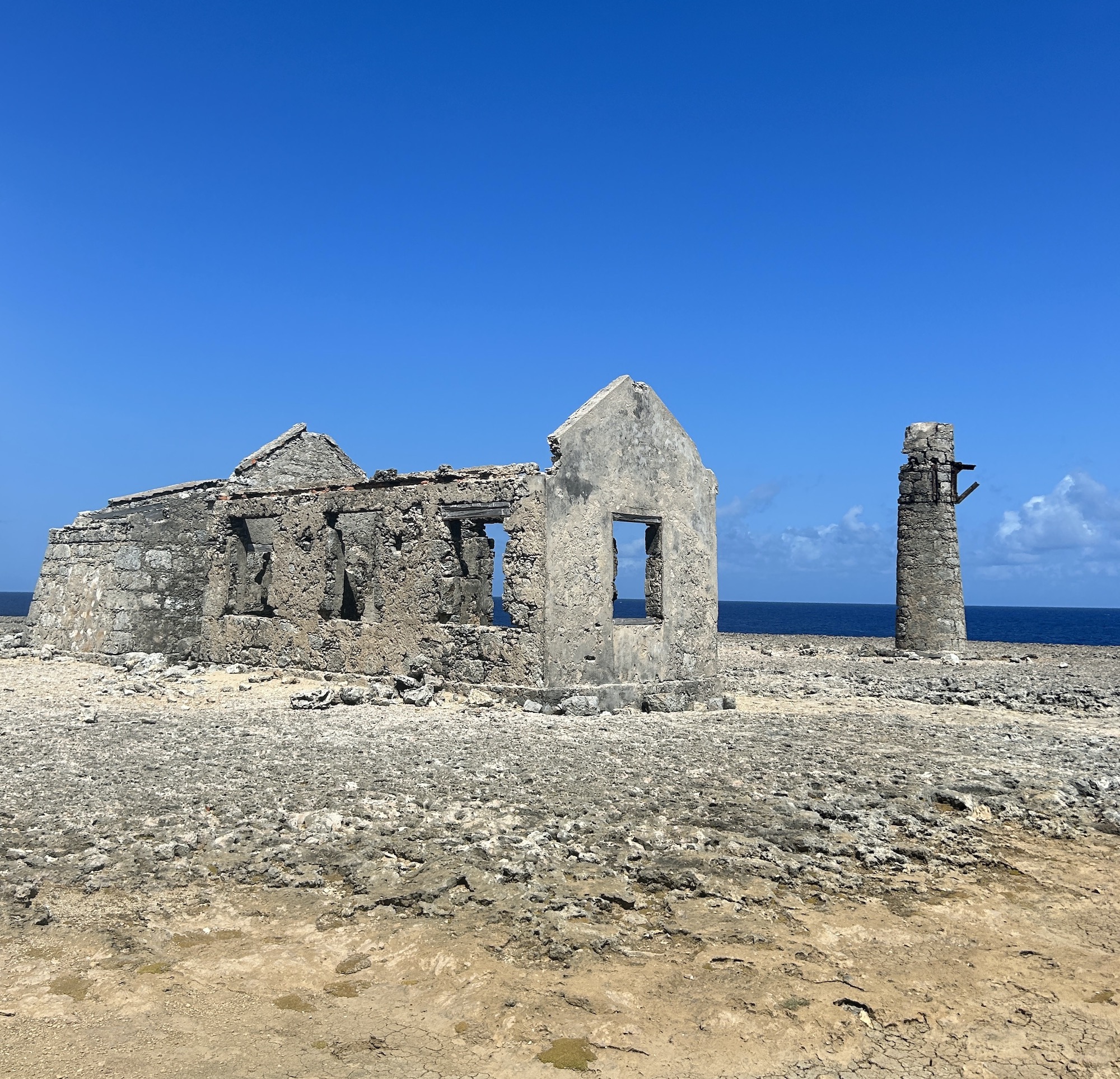
We had now rounded the top of Bonaire and were headed down the west coast where we joined up with the short route road. I wish I could say the road got better after this, but it didn’t. However, we did finally arrive at Wayaka and followed the signs to Wayaka II which was a very small beach down a series of tricky steps. We had been in the park now at least two hours and finally got into the water.
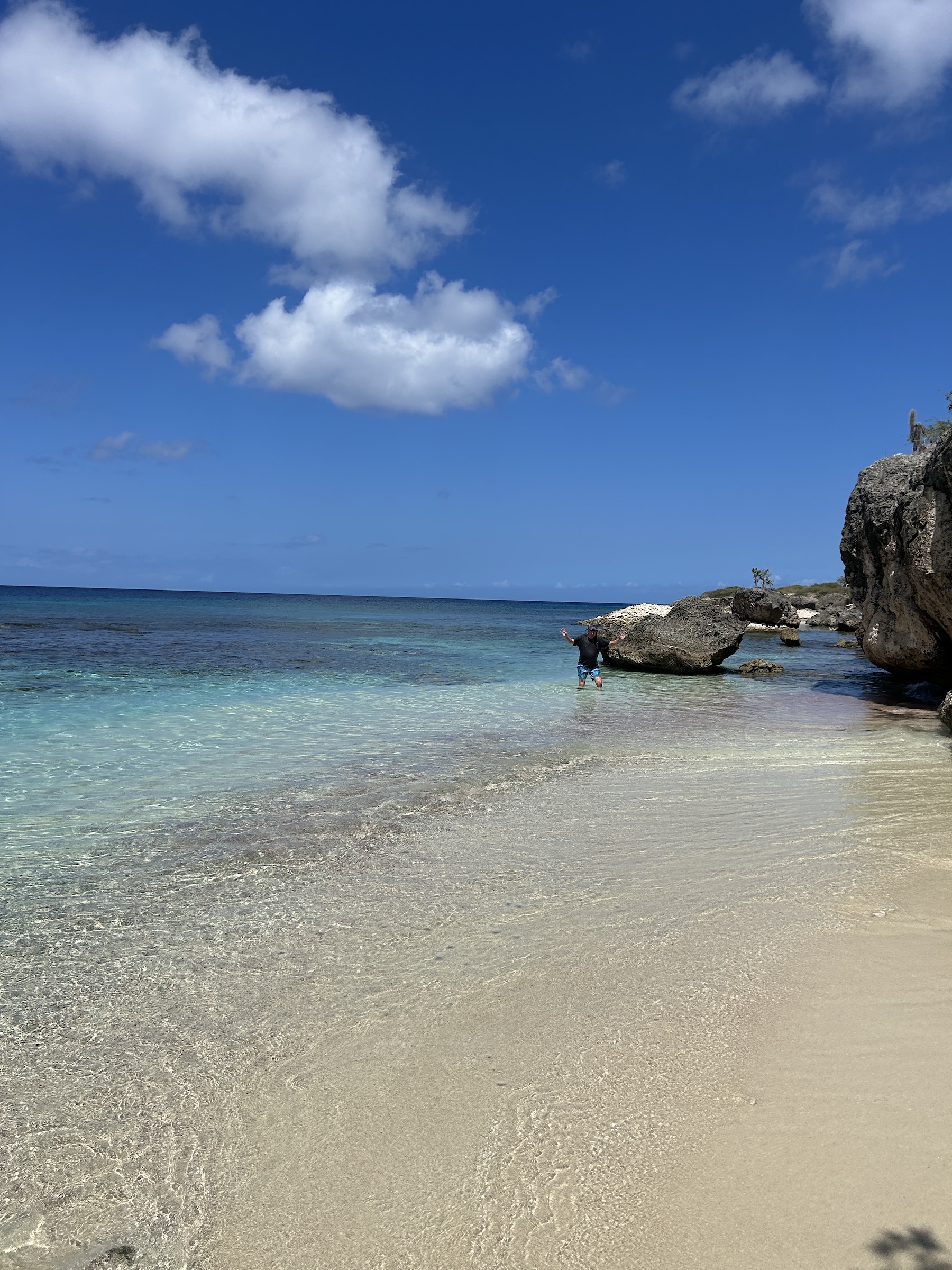
So was it worth all the effort to get here? In retrospect, no. By that I mean that we later found spots as good or better than Wayaka II much closer to our resort and that didn’t require a bone rattling ride to get to. There was the largest school of blue tang I have ever come across, but other than that nothing that special.
The next thing of note in Washington-Slagbaai NP was the restored station at what in English was Goat Slaughter Bay. It was here that the goats grown for their meat were slaughtered. They are still trying to eradicate the feral goats on Bonaire, but apparently without a lot of success. There are supposedly over 11,000 goats within the park boundaries, but they did such a good job of hiding that we didn’t see one.
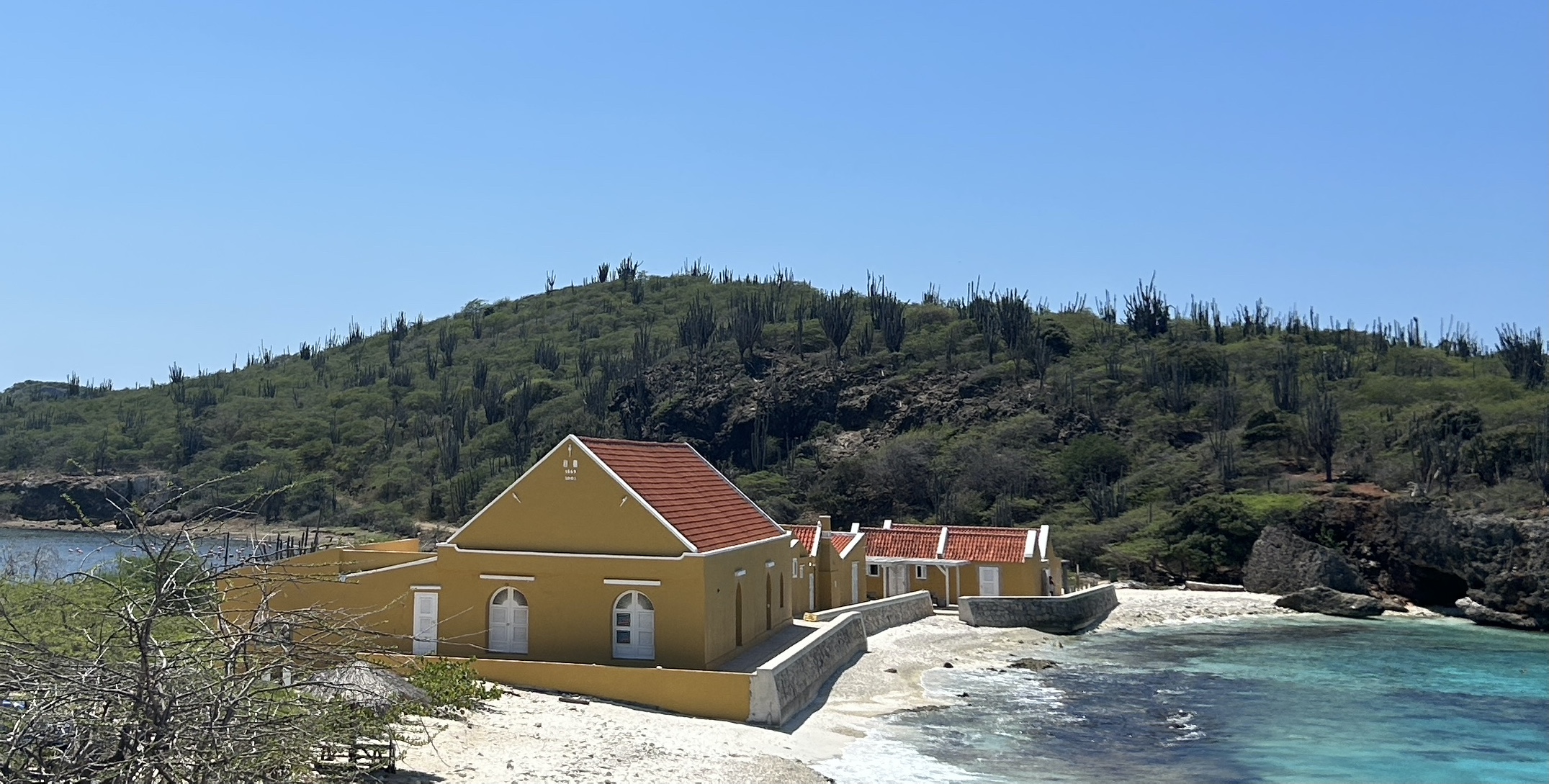
What we did see just past the station at Slagbaai salt lake were hundreds of Caribbean flamingos which was probably the highlight of the park.
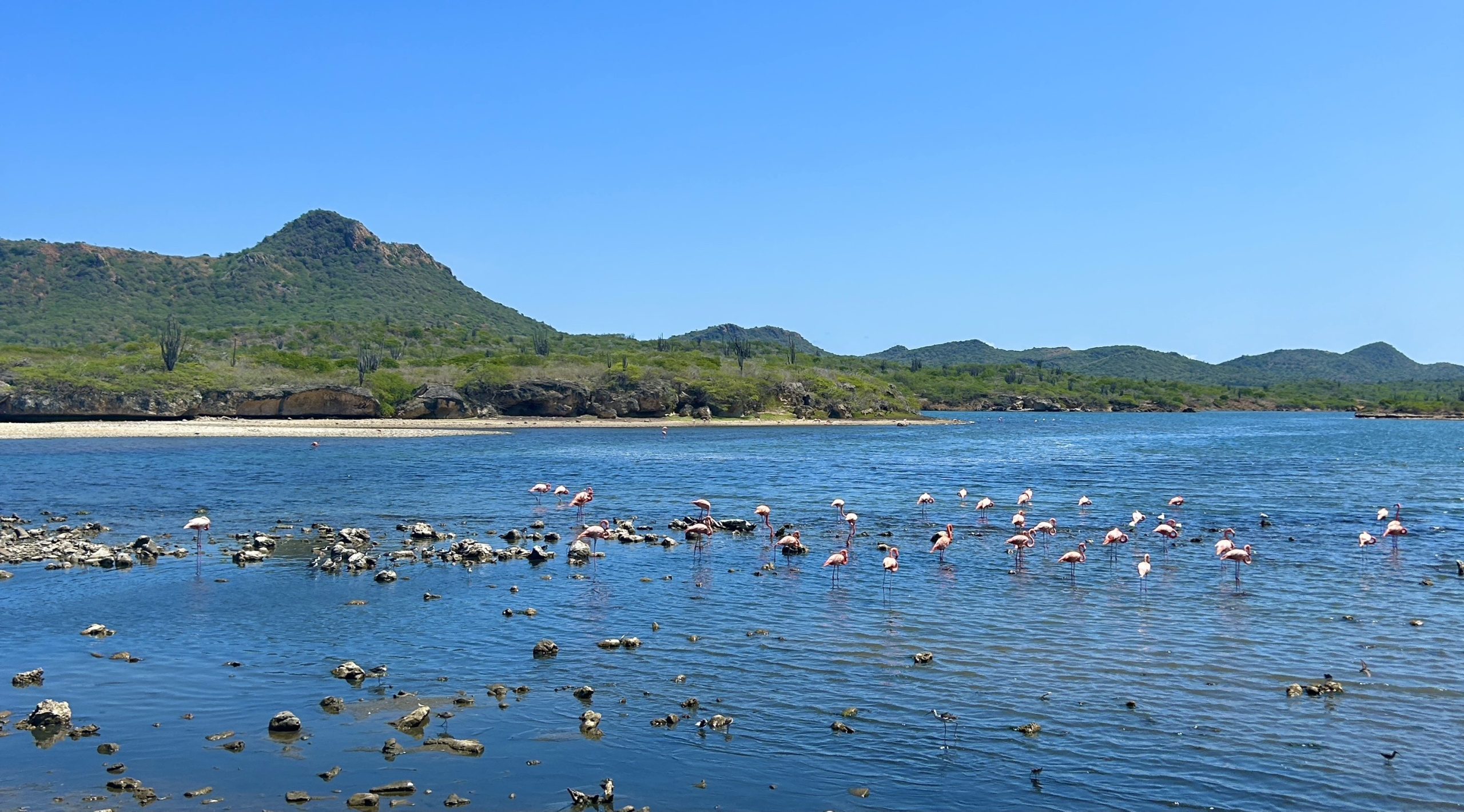
From here it seemed to take an eternity to get back to the main entrance and sure enough, when we did, it had been well more than three hours since we began.
I’m glad we did the long loop, but it’s the type of experience you do once and that’s enough. And if you are looking to snorkel, keep reading because I have some good spots coming up.
If you are looking for a decent place to eat after touring the park check out Kos Bon So in Rincon where you’ll find authentic Creole dishes in a nice al fresco setting right beside Rincon’s Walk of Fame.
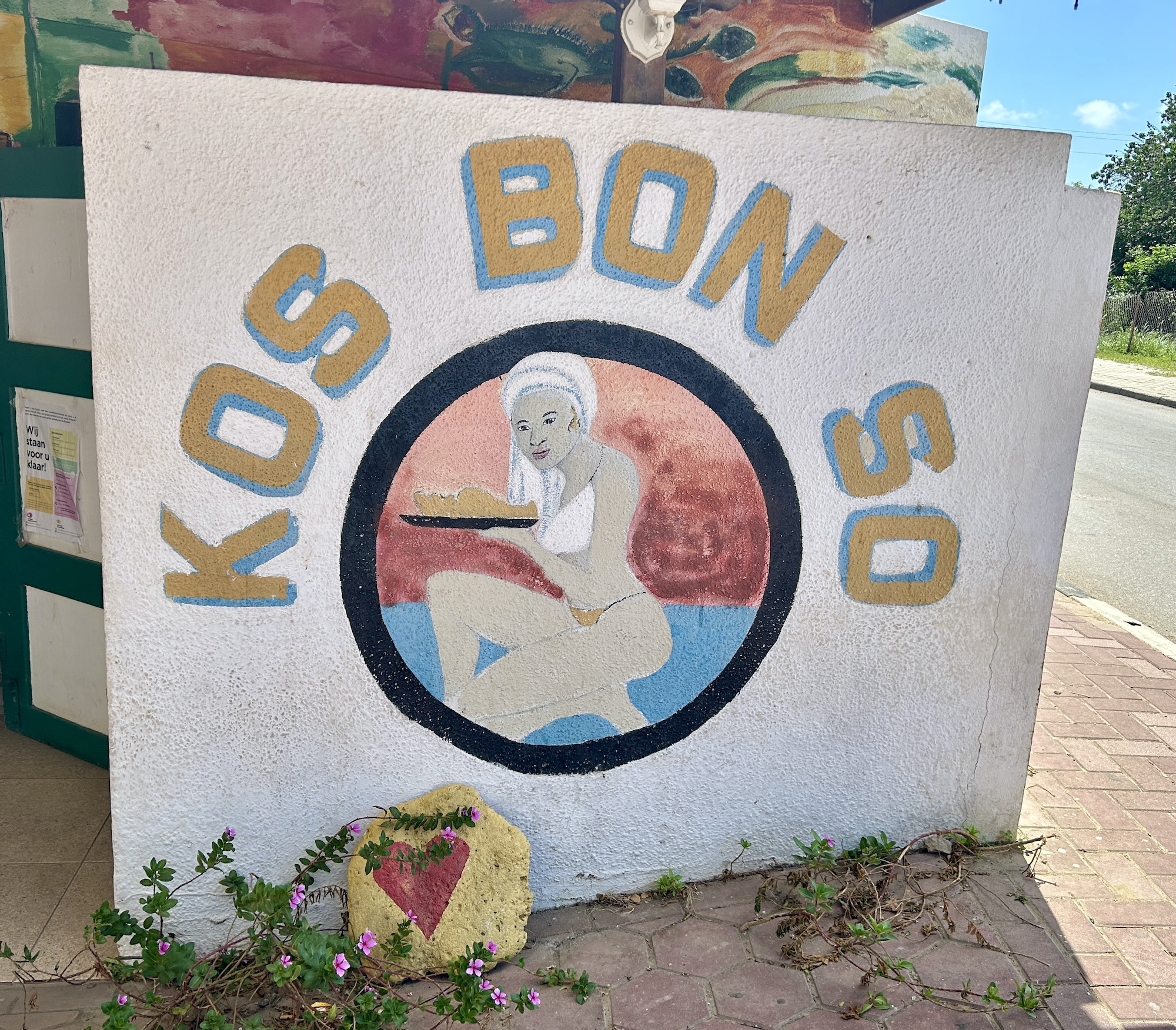
The next day Lenore and I drove south from the Windsock resort to look for decent snorkelling sites and found a number that were well marked and relatively easy to get into the water. Margate and Red Beryl were the best. You can find videos of both places and a number of others on Bonaire at Snorkeling Quest. This is also where you’ll find the two sets of slave huts which are very photogenic despite their horrific past.

You’ll also find this orange coloured obelisk which marked the spot where ships picking up salt could safely anchor.
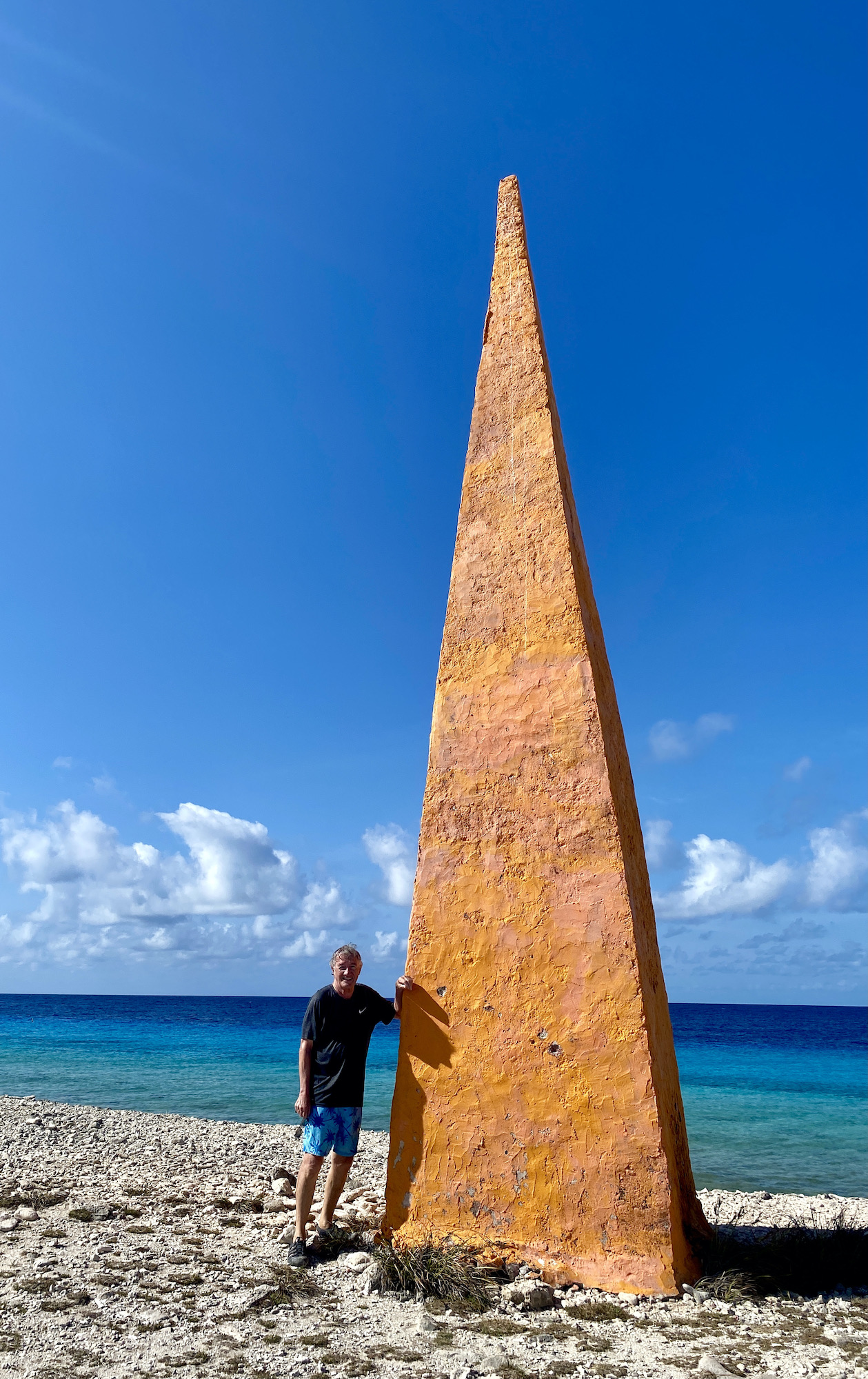
At the very southern tip of Bonaire is Lacre Punt Lighthouse after which the road turns north and you end up at Lac Bay and Sorobon resort complex.
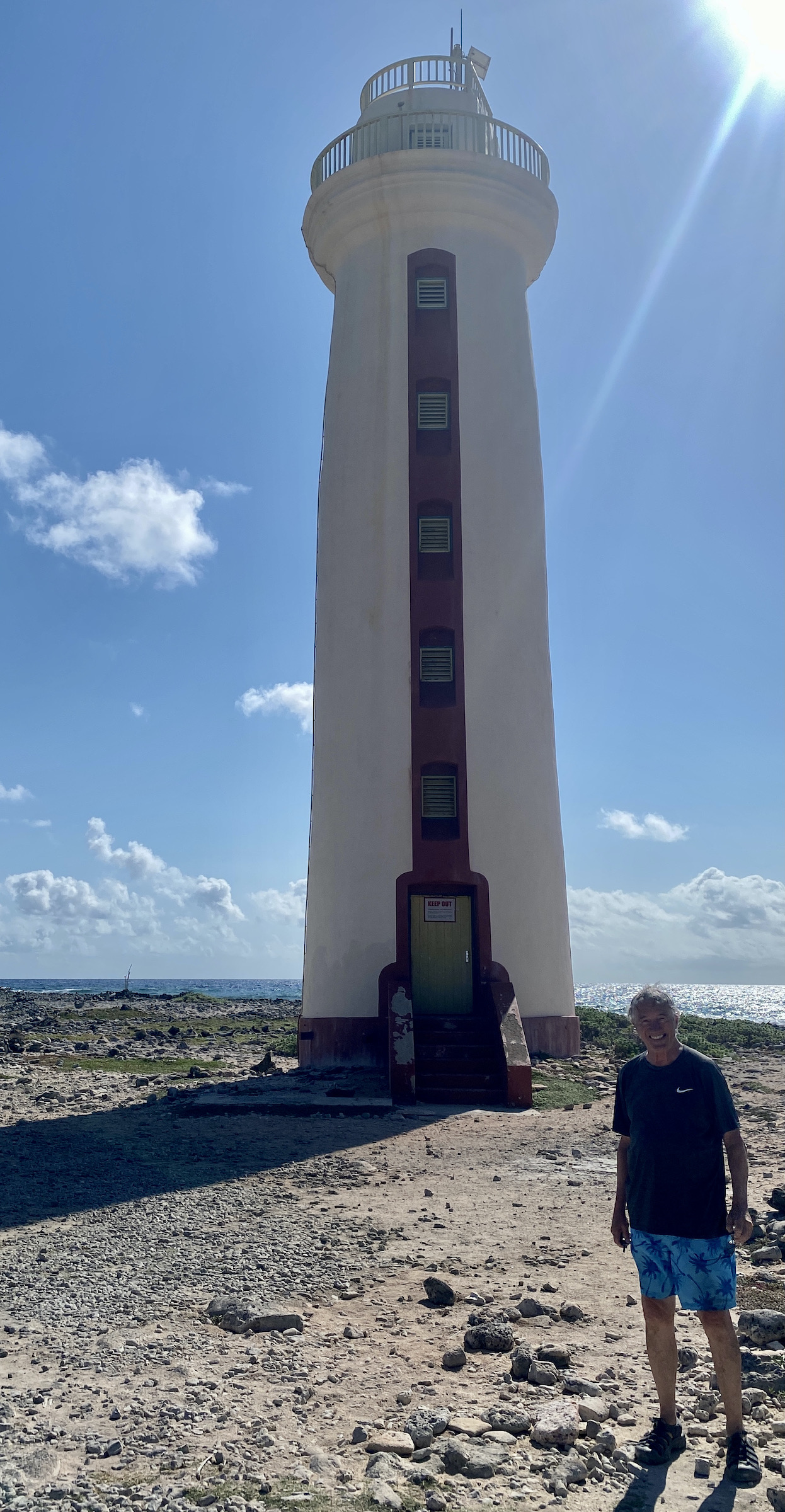
Lac Bay is a huge shallow bay that never gets more than six feet deep and in most places is much less. It’s a long walk from shore to the outer reef and like Washington-Slagbaai Park I would recommend doing it once.
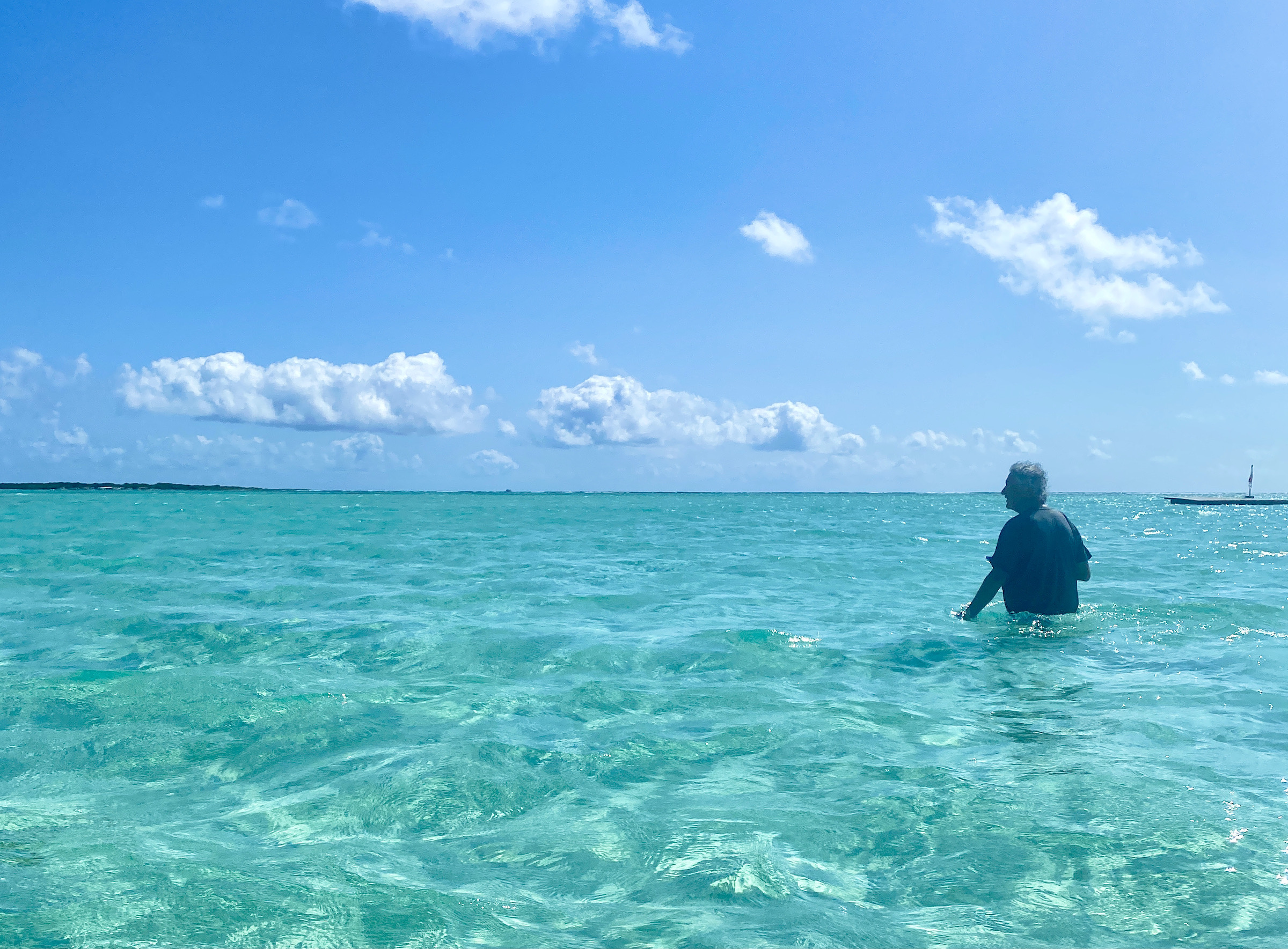
It’s a quite different experience than any of the other snorkelling spots we tried. Lenore found this lovely sea biscuit during this outing which we returned to the sea after the photograph.
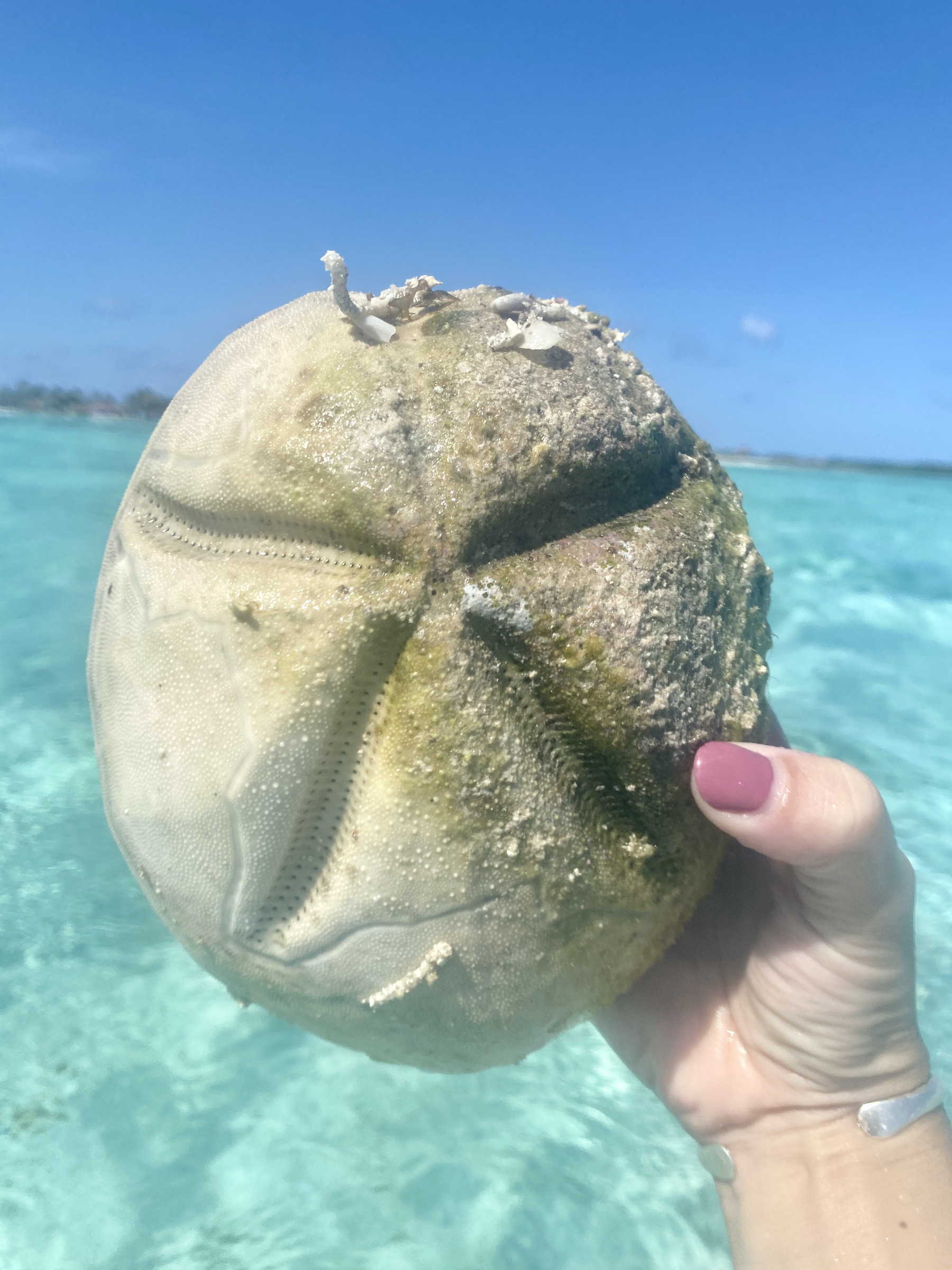
The entire drive through this part of Bonaire is otherworldly as for most of it there is only a narrow strip of land between the Caribbean and the huge salt lake where Cargill has created gigantic salt pyramids. While it is paved, much of it is one lane and you need to meet cars coming the other way at one of the pullover spots every kilometre of so.
Once you get past Lac Bay the road turns inland and you’ll probably run into some wild donkeys before once again passing the Donkey Sanctuary and arriving back on the main road.
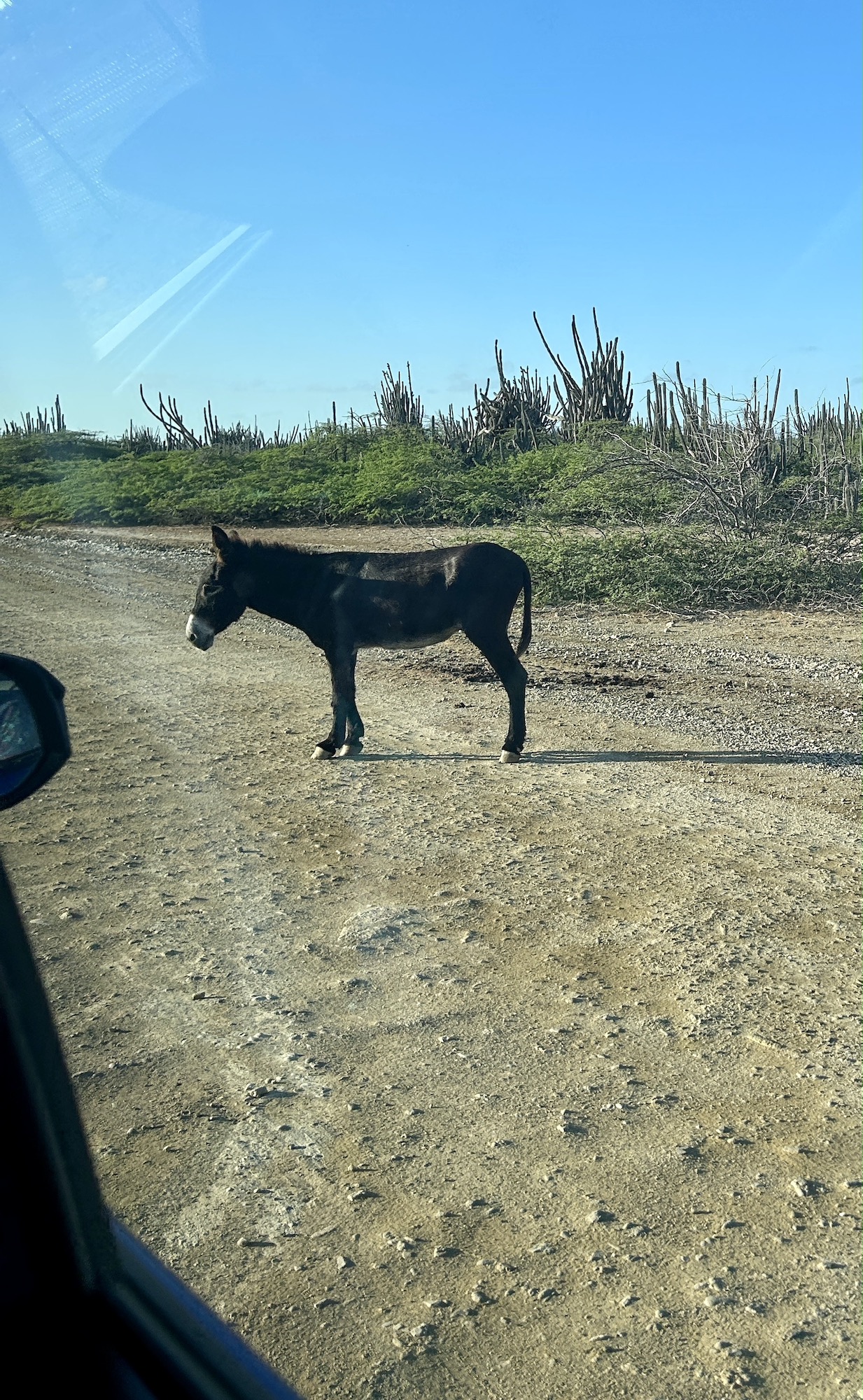
Now here’s the real irony about snorkelling in Bonaire, at least for me. Not more than a kilometre from Windsock is Te Amo beach which is a real beach and has some of the best snorkelling on the island. We only tried it after these other places and found it to be everything you’d want in a snorkelling site. It’s super easy to get to the reef literally just off shore, there’s plenty of fish and the Kite City food truck on site has the best tuna burger on earth. Sun, snorkelling, beer and great food, all within walking distance. So I had gone all over hell’s half acre looking for the best snorkelling and it was right under my nose.
The Mangrove Sanctuary
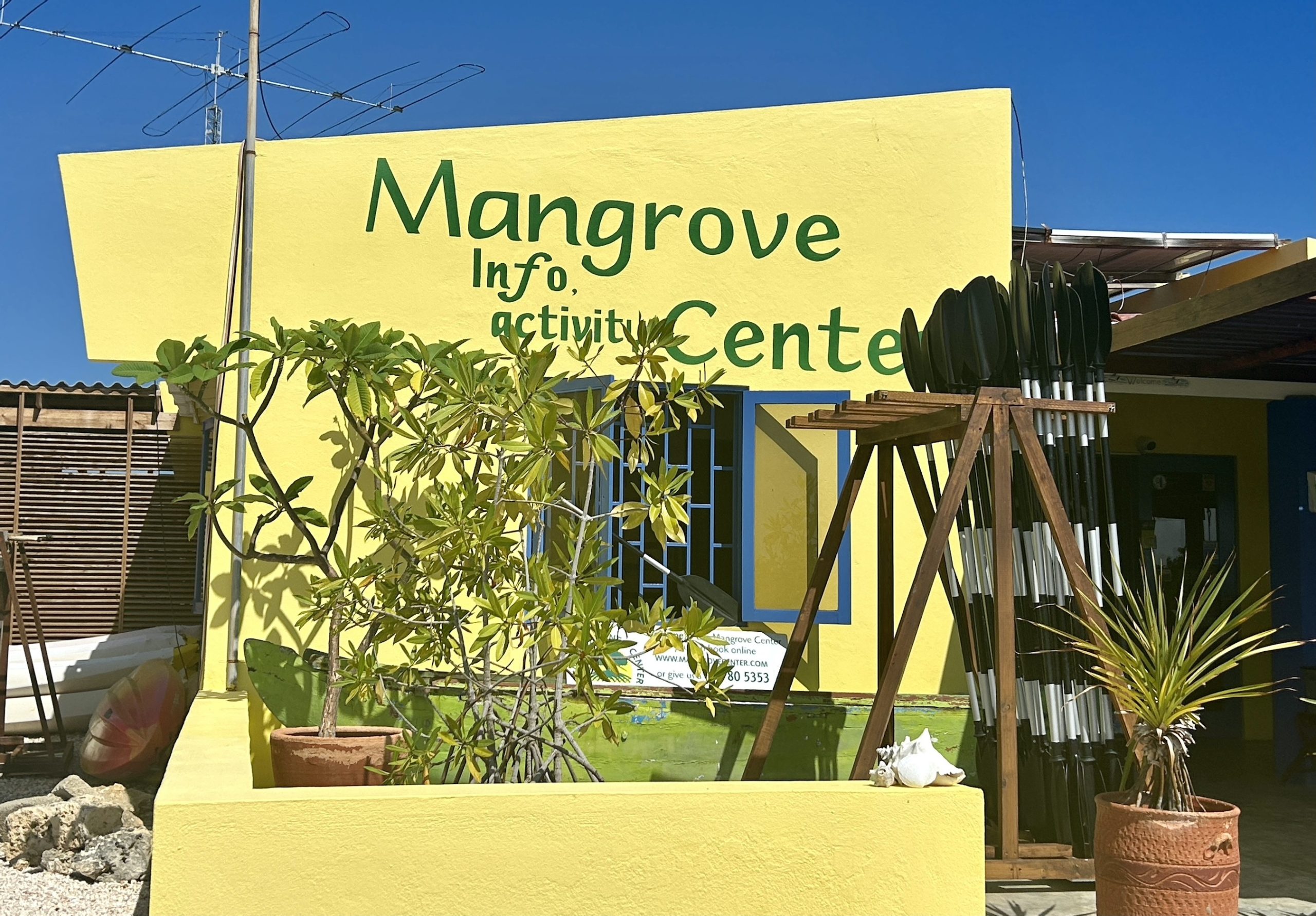
There’s one more activity we participated in on Bonaire that I probably would have passed on if I had known what was in store for us.
Most of Lac Bay is surrounded by one the best preserved mangrove forests in the Caribbean. One of the reasons for this is that almost all of it is off limits to the public, letting it do what nature intended – act as a nursery for hundreds of different species of fish, shellfish, sea turtles and birds. However, one company, the Mangrove Center is permitted to take tourists through a small portion of the bay to get an up close view of this nursery. Now I’ve kayaked and canoed through mangrove forests many times, but the Mangrove Center offers something more; the chance to snorkel in a mangrove forest. Having seen how clear the water was in Lac Bay from our trip to Sorobon, I thought it would be quite different from the murky waters of southwest Florida. It was different, but not in the way I expected.
The kayaking portion of the two hour excursion went smoothly enough and was about what you would expect in terms of these type of trips. Here’s a short video of the group.
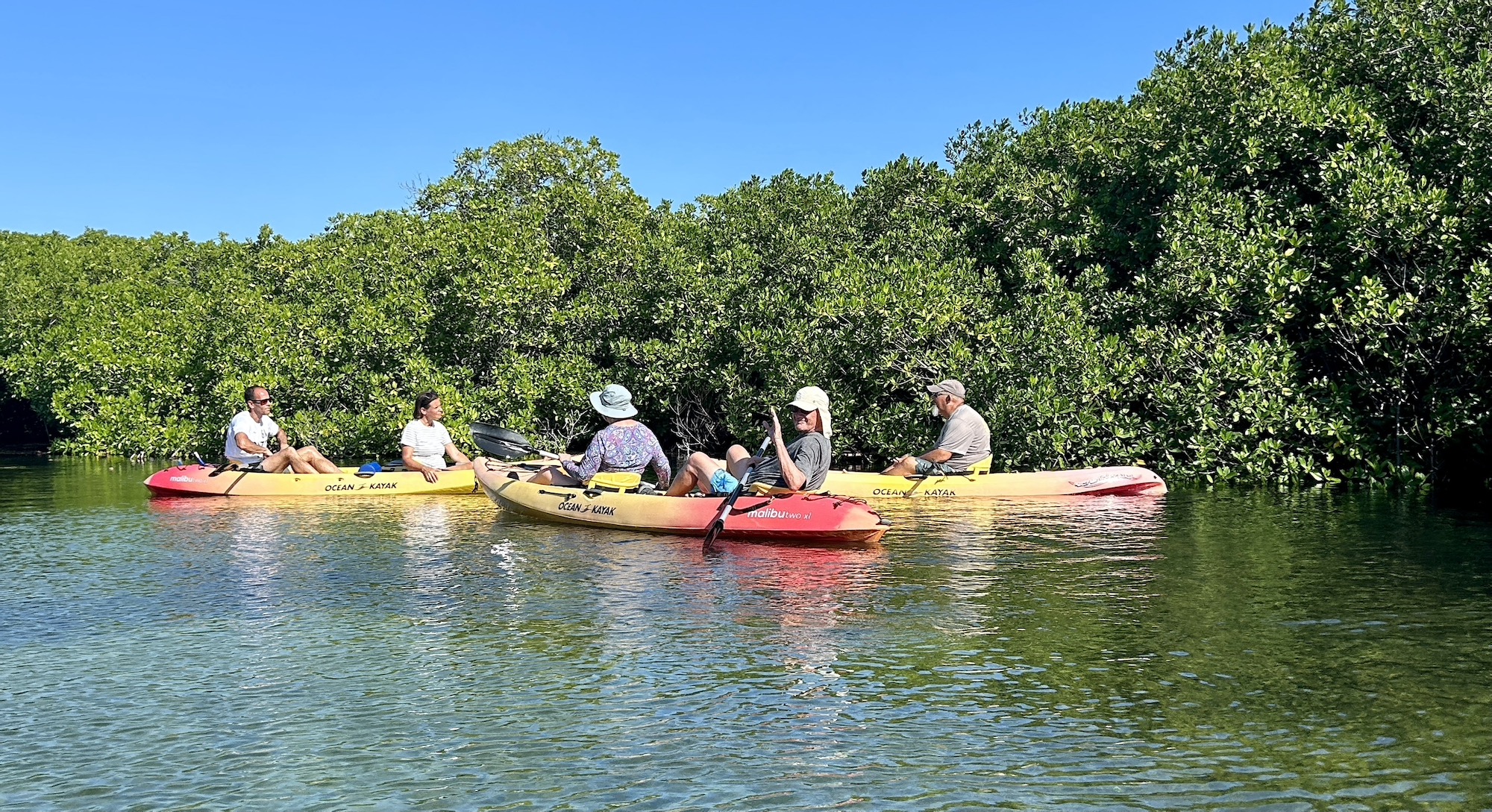
Then we rafted up in about five feet of water, got out and put on our snorkelling gear. So far so good. I did notice that there was a fairly decent current behind us as we followed the guide through a narrow channel. Unfortunately the current made visibility less than ideal and we didn’t see much. After a couple of hundreds yards we came to a clearing and it was now time to go back the way we came. That meant swimming against the current which was now a serious tidal inflow. Swimming against it was next to impossible and most of the group had to pull themselves from one mangrove root to another. Not only was it exhausting, but the mangrove roots have barnacles and other sharp objects that left Alison with a rash for weeks afterward. Now I understand that we happened to go on a day when the tide was changing and that this was not the usual snorkelling experience, but be forewarned. Before you book find out what the tide will be doing.
The Brass Boer
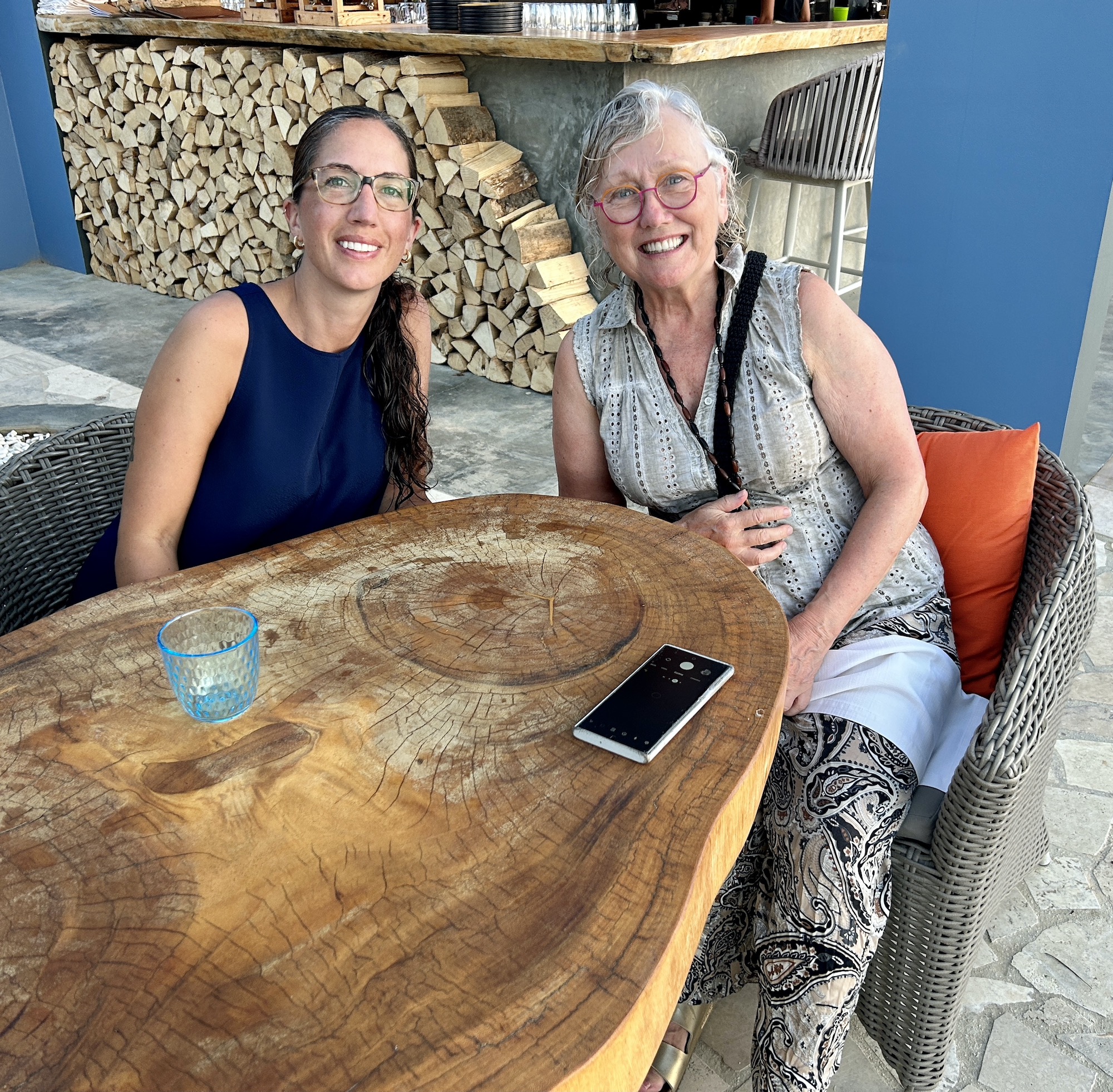
I don’t want to end this post on Bonaire on a down note. On our last night Lenore treated us to one of the best meals we’ve ever had in one of the nicest settings. The Brass Boer restaurant in the Delfins Beach Resort is the Caribbean version of a Michelin starred restaurant in Zwolle in the Netherlands owned by Jonnie & Therese Boer. It’s seaside location is perfect for a sunset feast. Everything from the beginning to the end of this meal was exceptional including the service, the drinks and of course the food. Here is a gallery of items from that night. I would not hesitate to return to Bonaire just to eat here again.
- Gin Sour
- The Note Quite
- Spier Chenin Blanc
- Bread with Butter and Oil
- Amuse Bouche Both Ways
- Vegan Cauliflower
- Heart of Cabbage
- Watermelon
- Langoustine
- Espresso Martini – not
- Rice Pudding
- Beef Tartare
So, I learned a few things not to do on Bonaire on this first foray which will prepare me much better for a return visit next year. Maybe I’ll see you there.


